
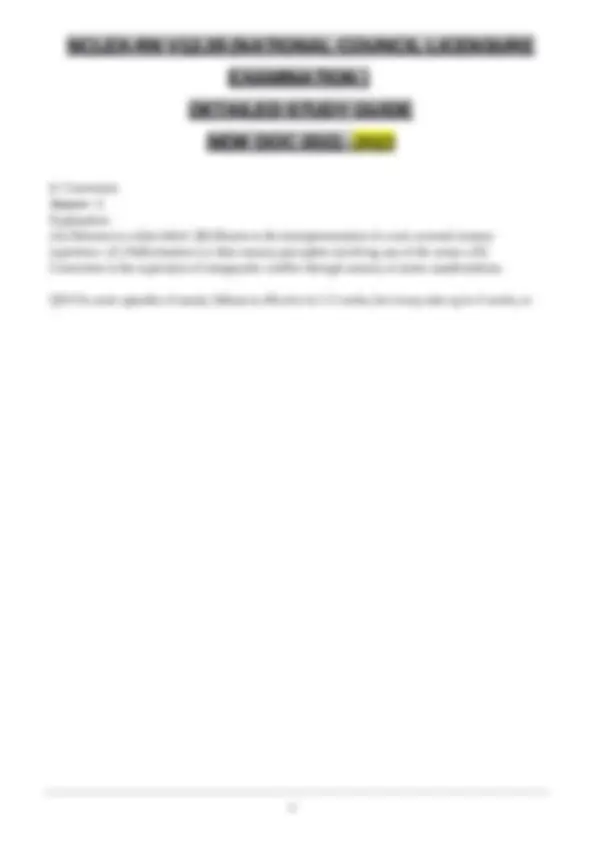
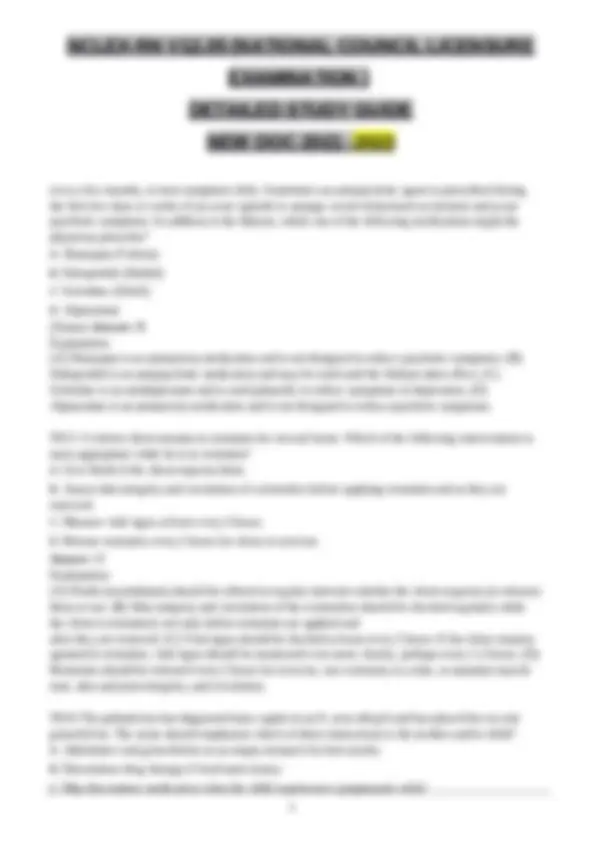
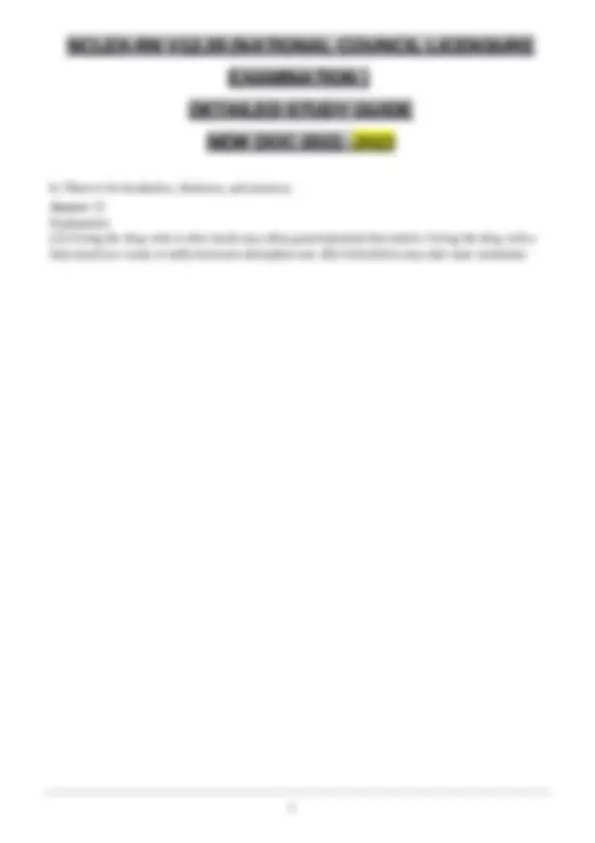
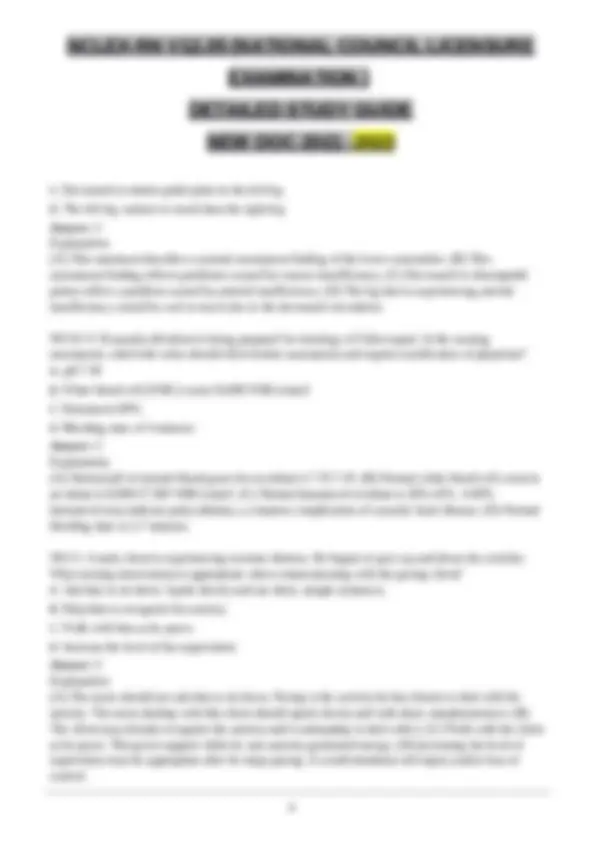
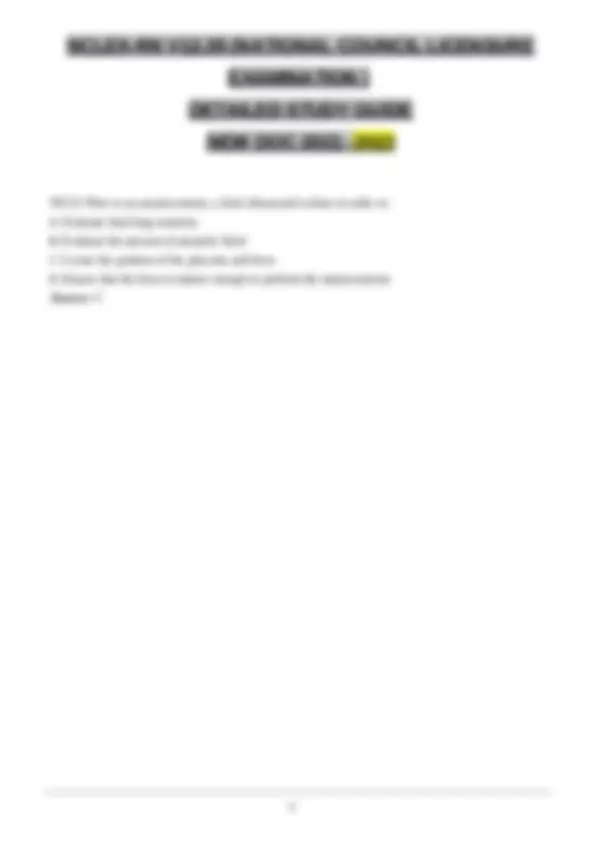
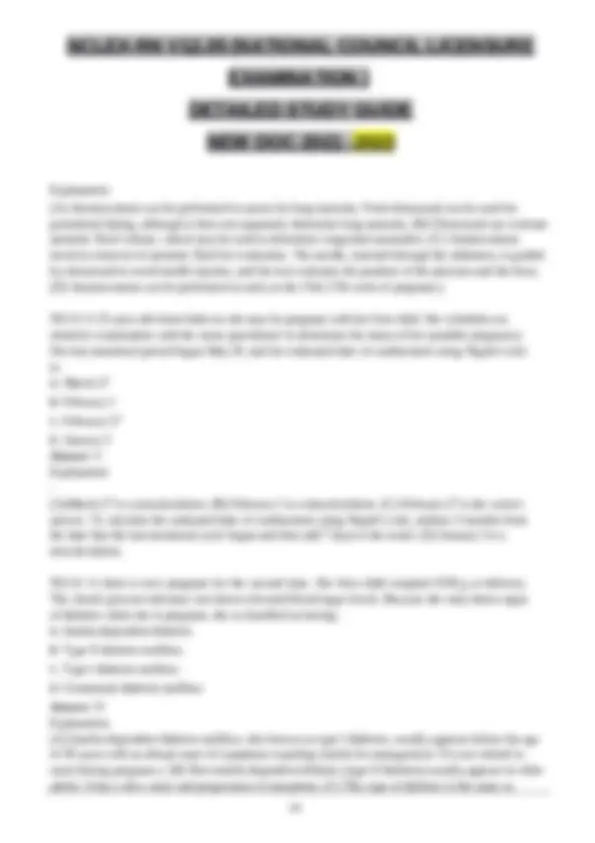
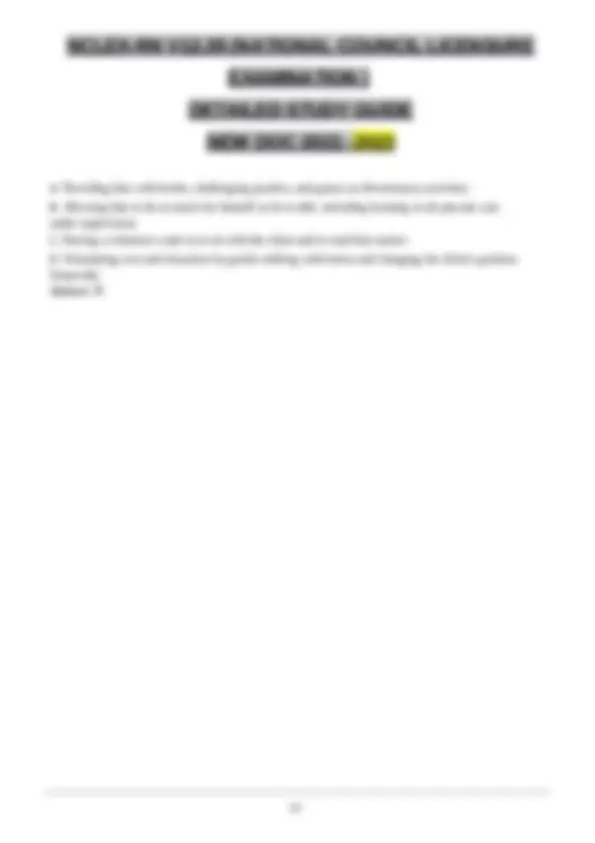
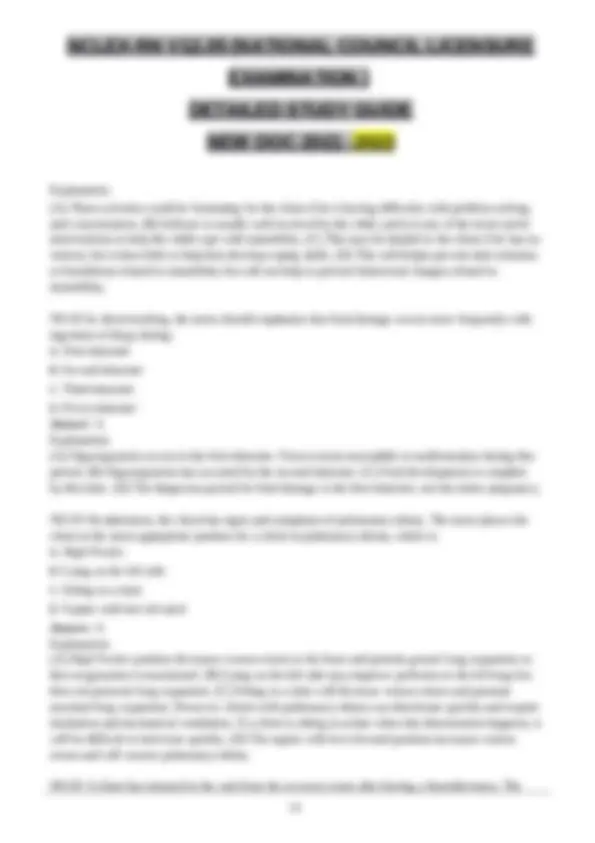
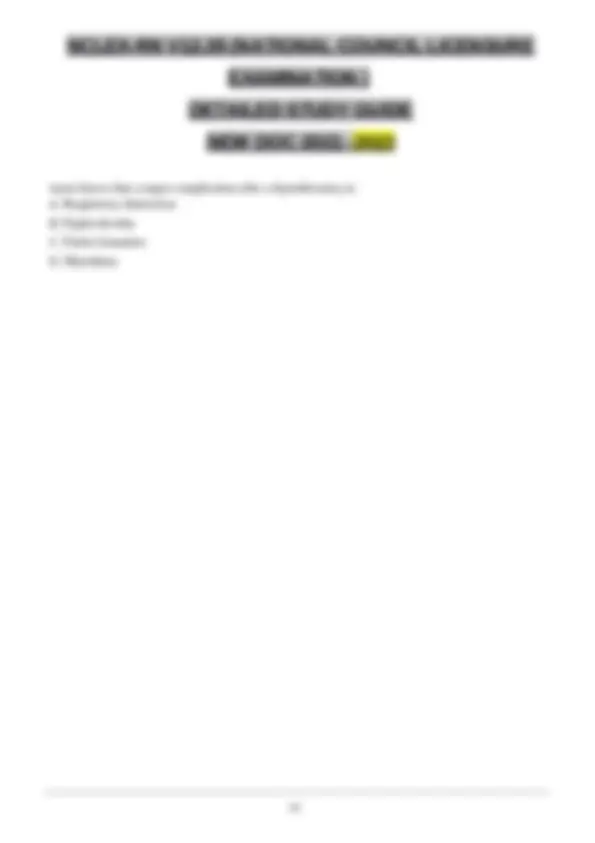
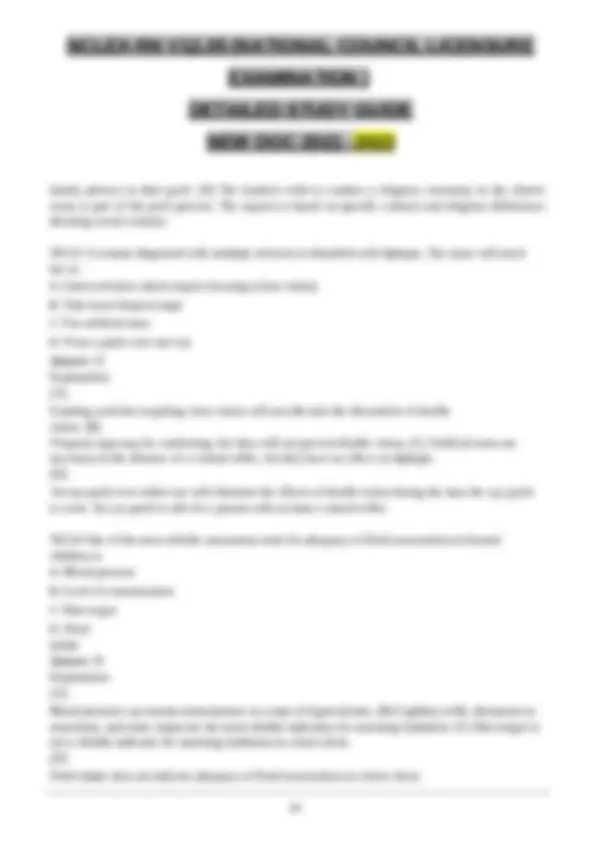
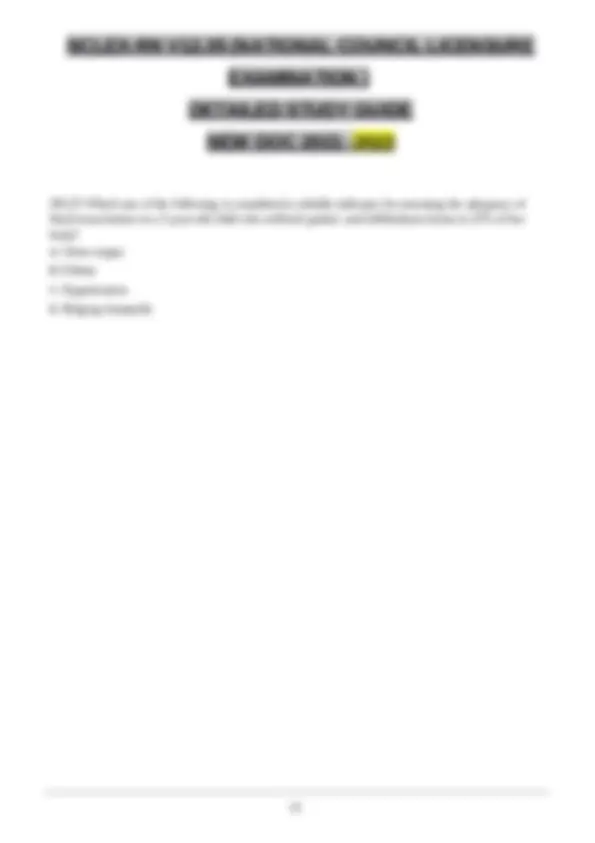
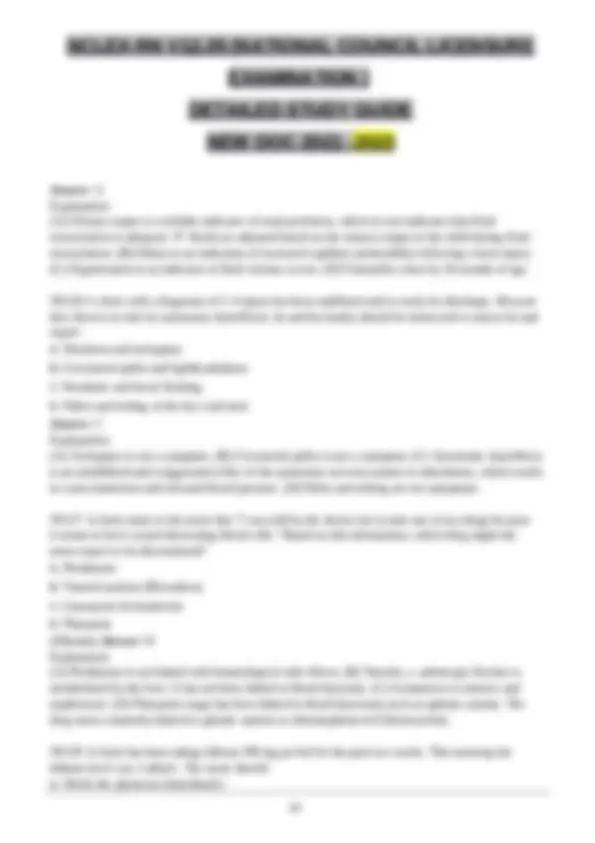
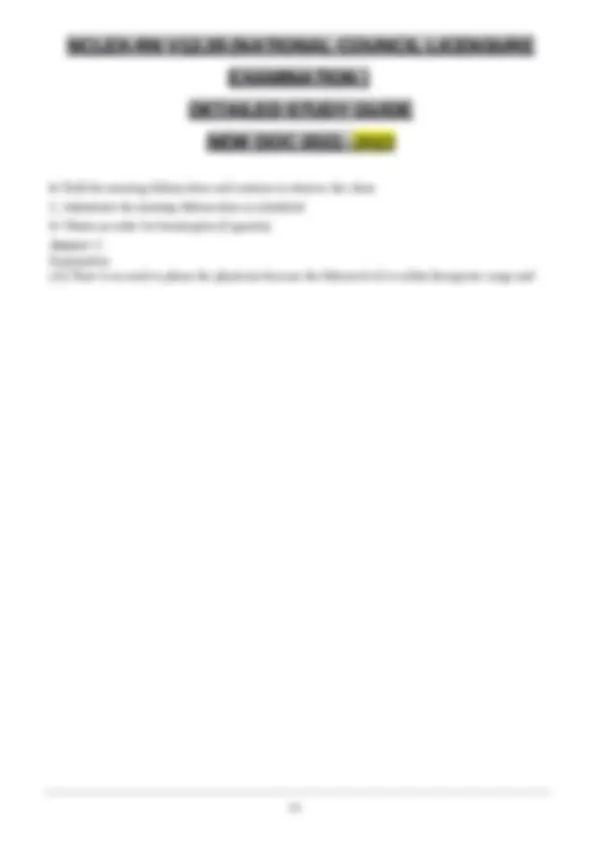
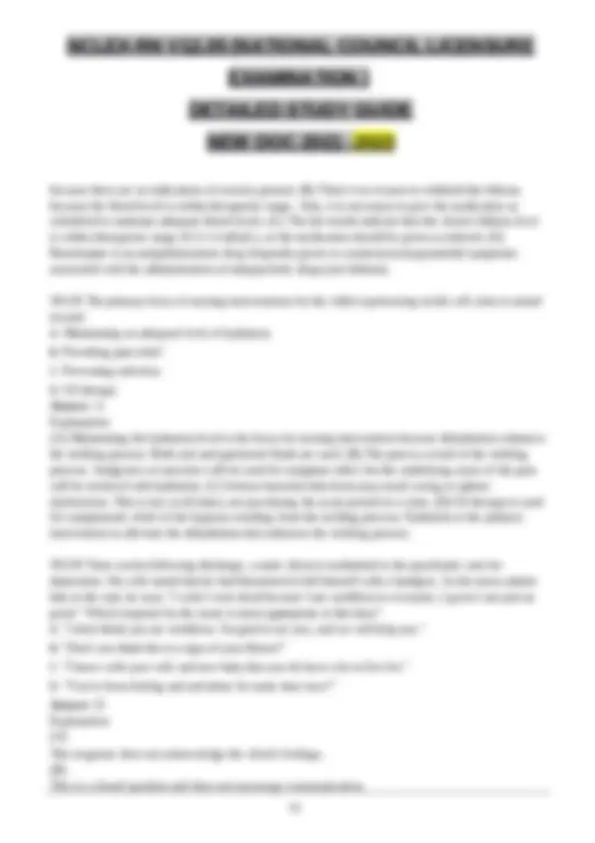
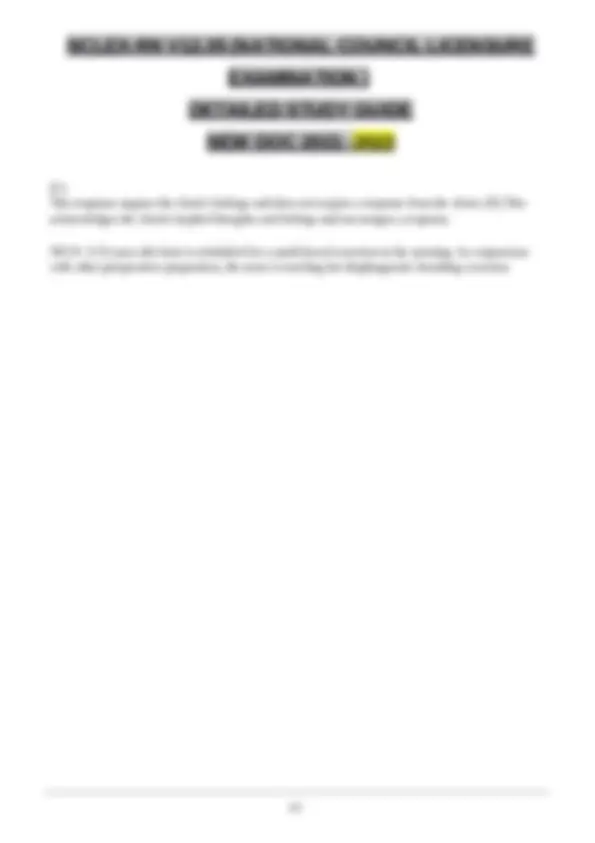
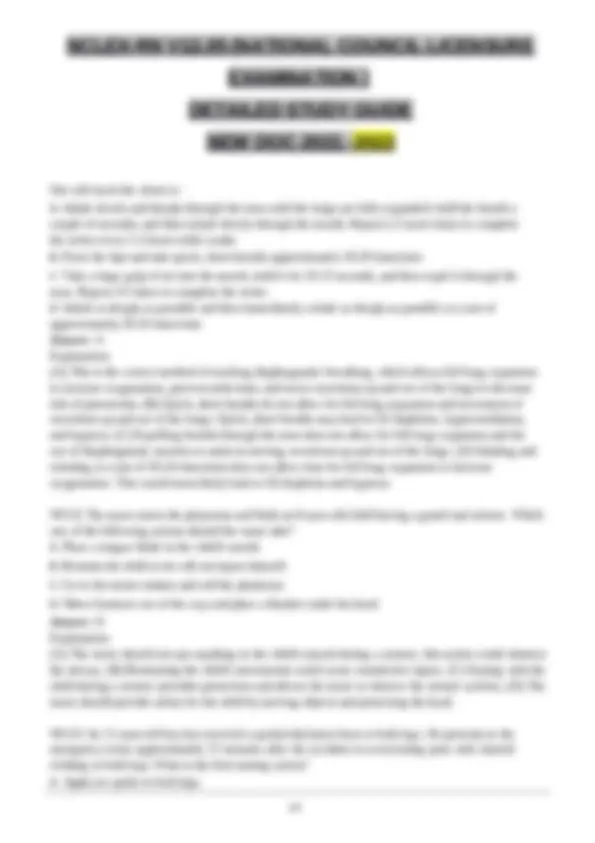
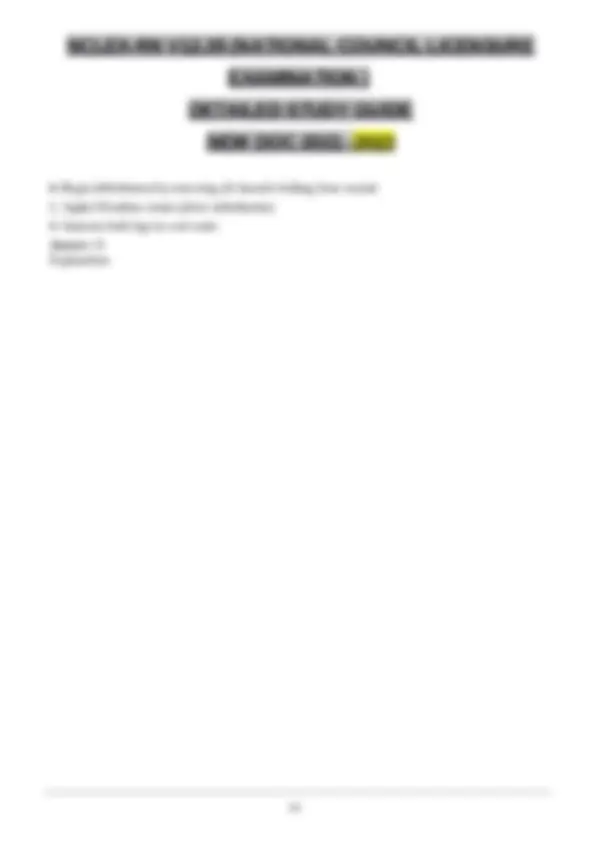
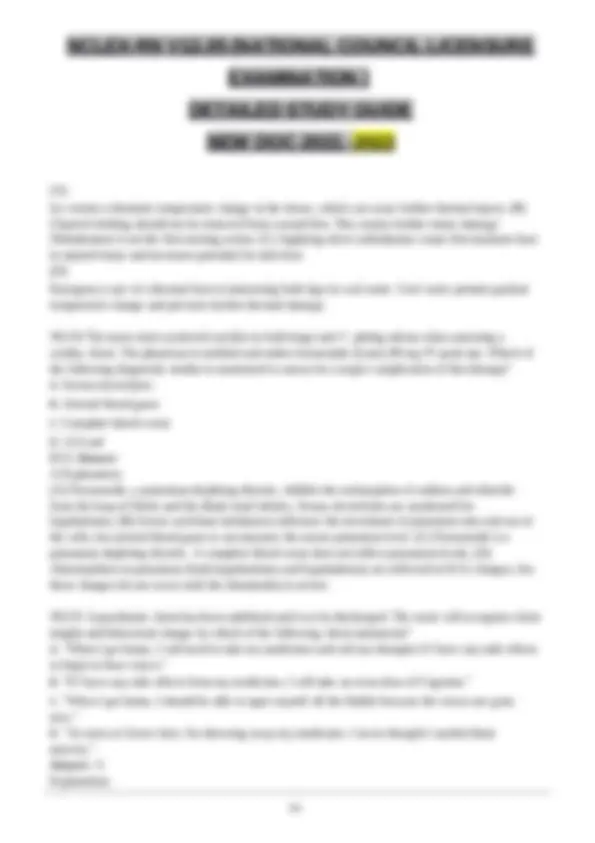
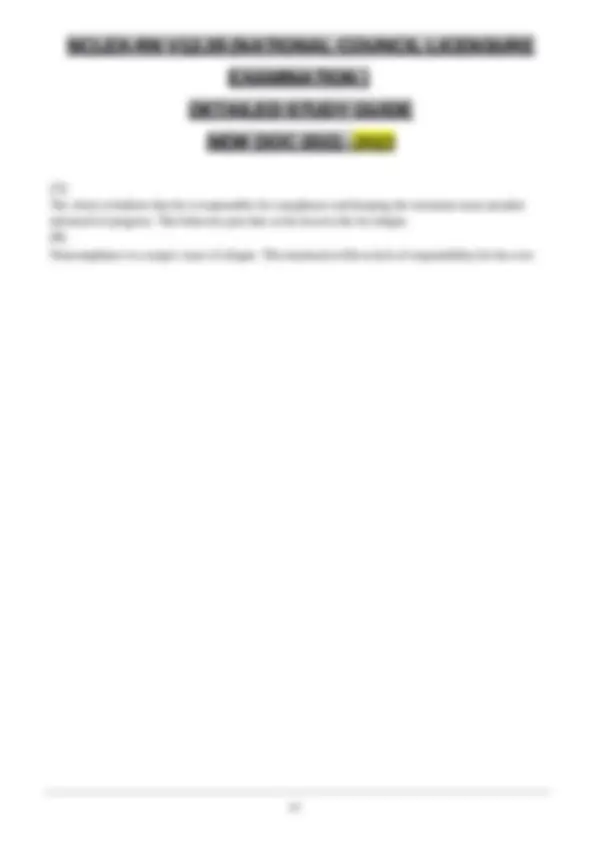
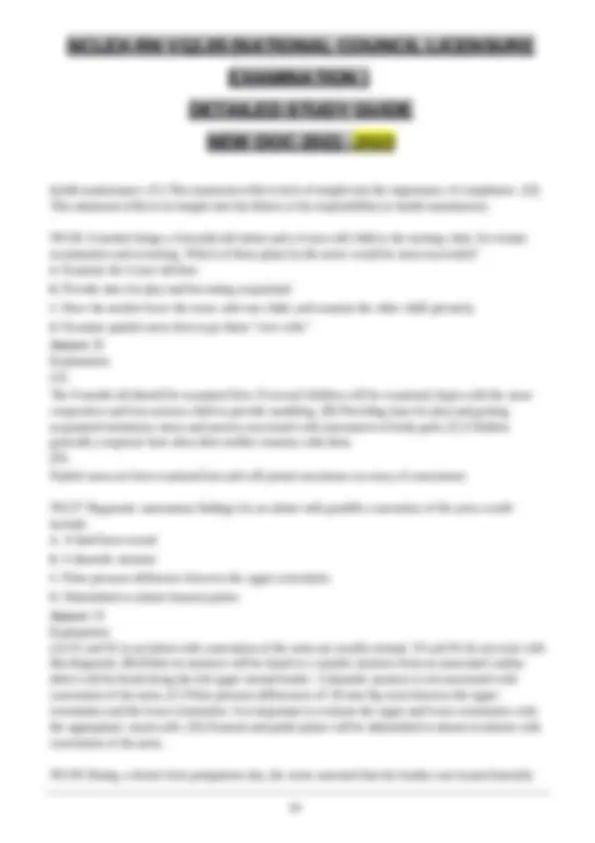
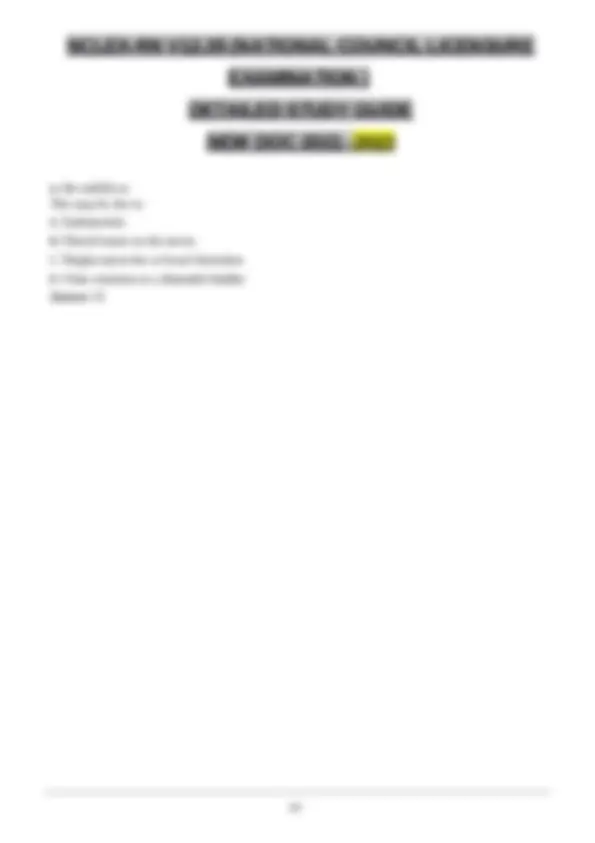
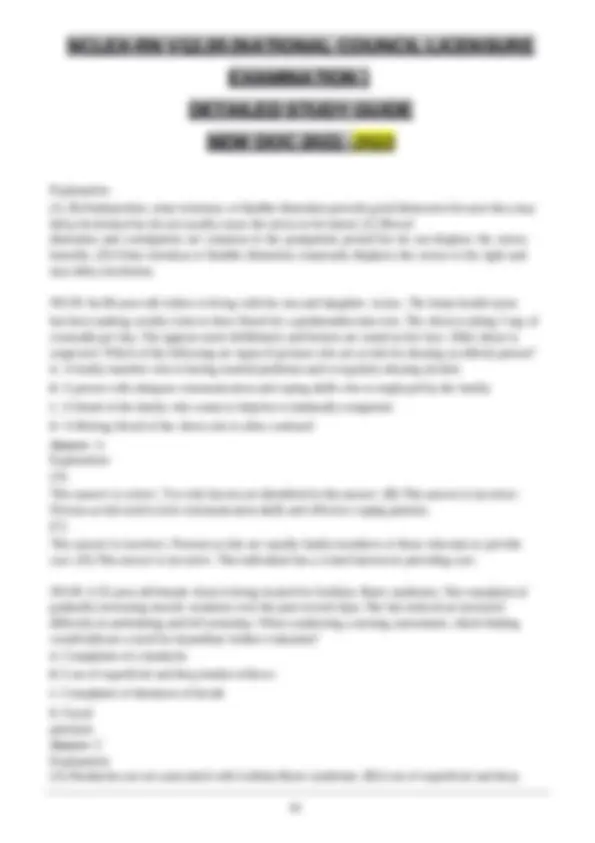
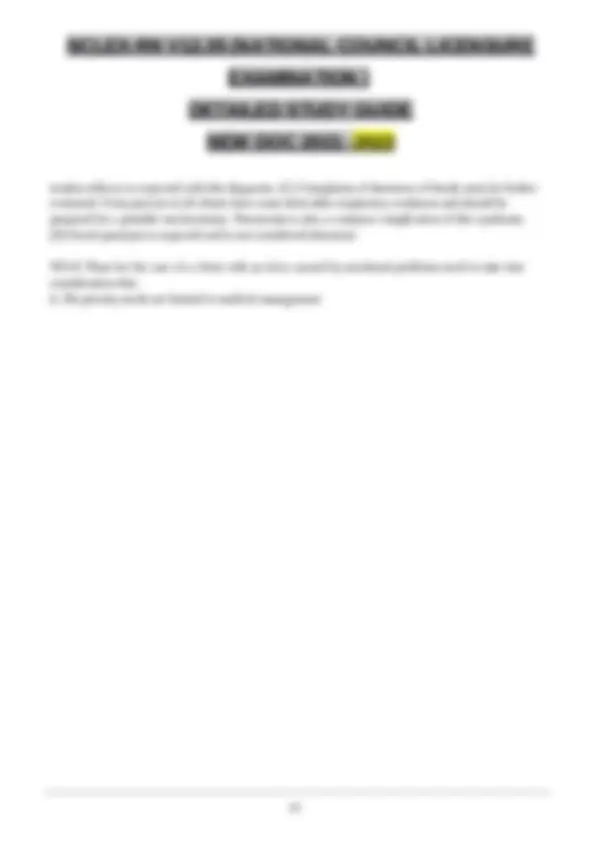
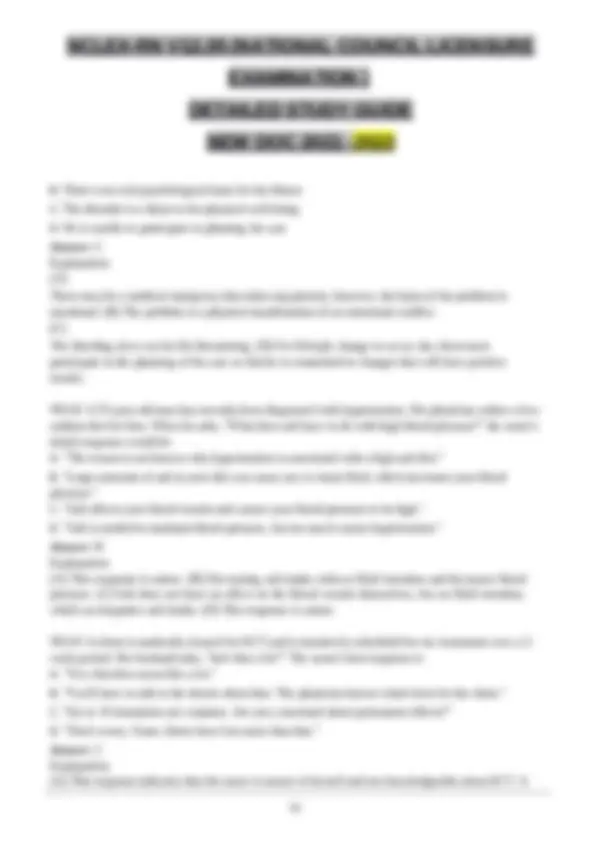
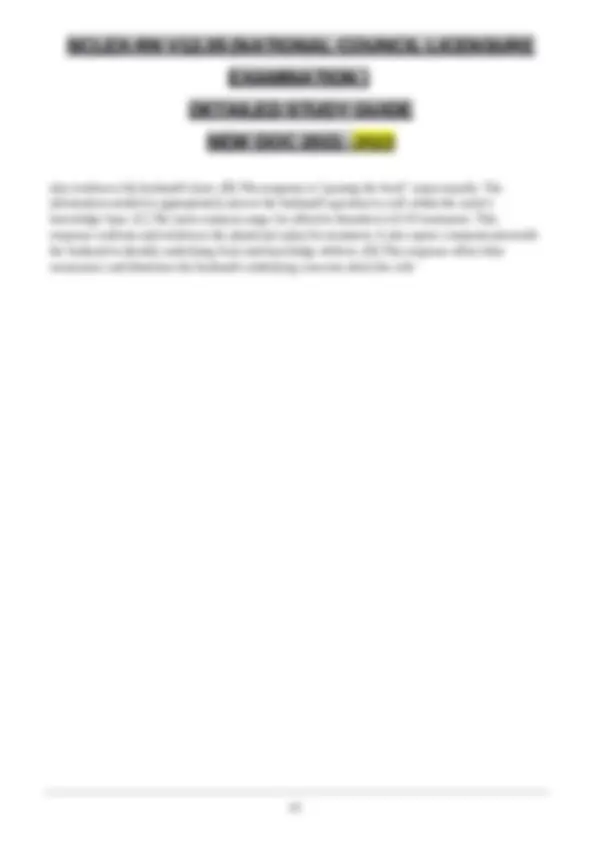
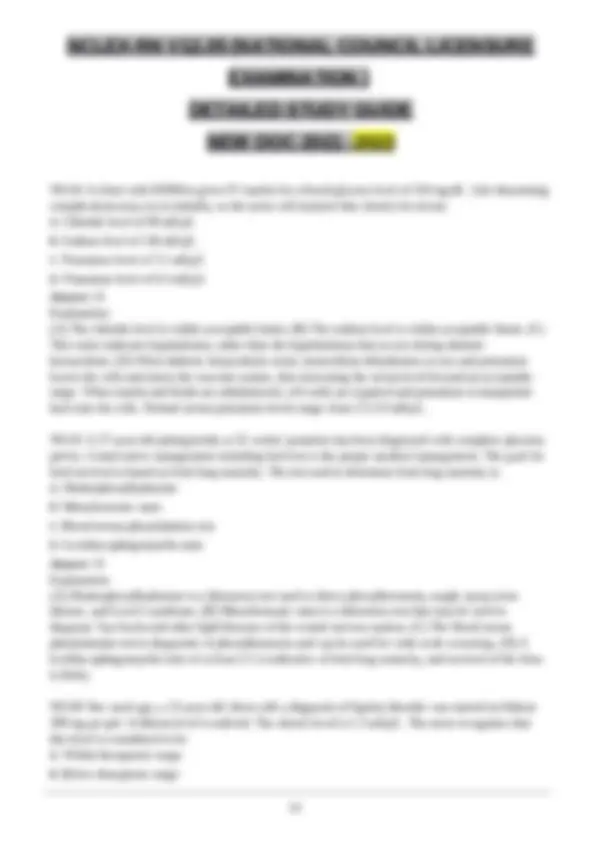
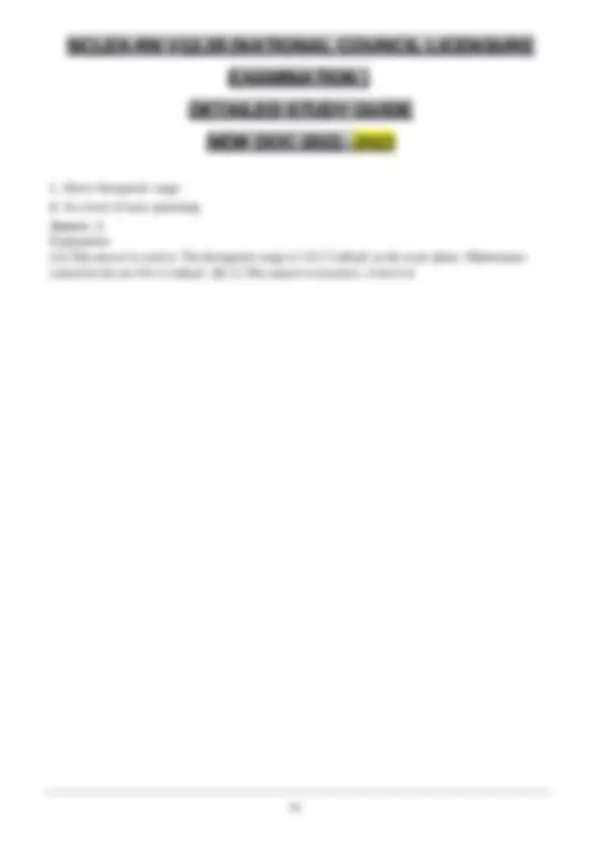
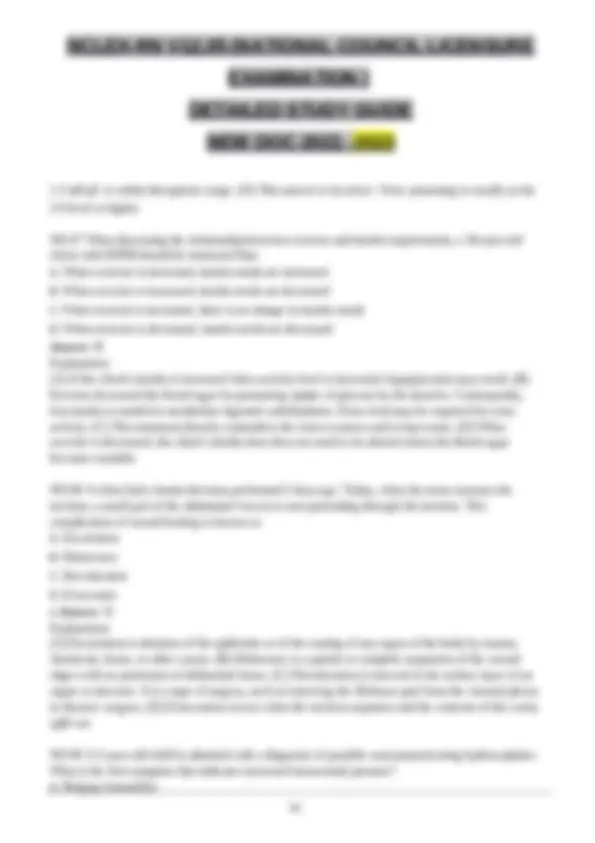
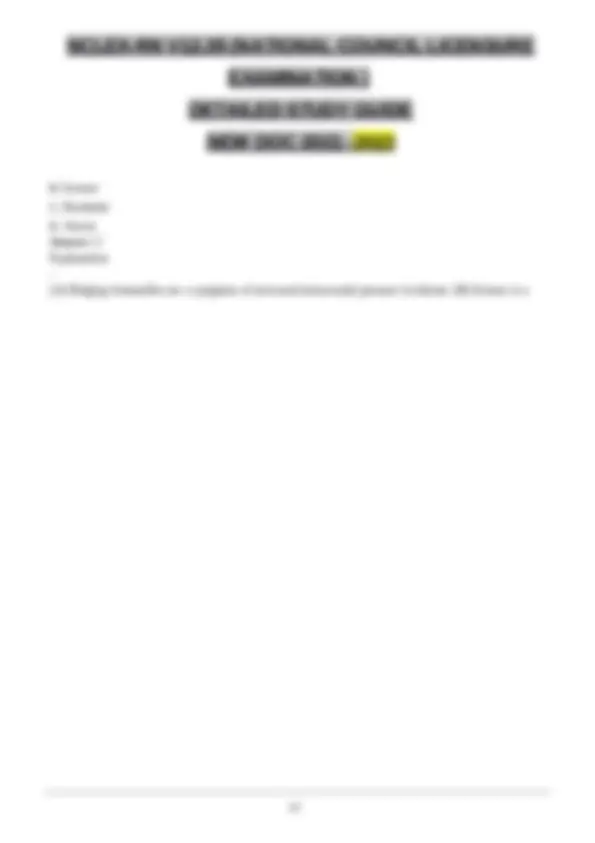
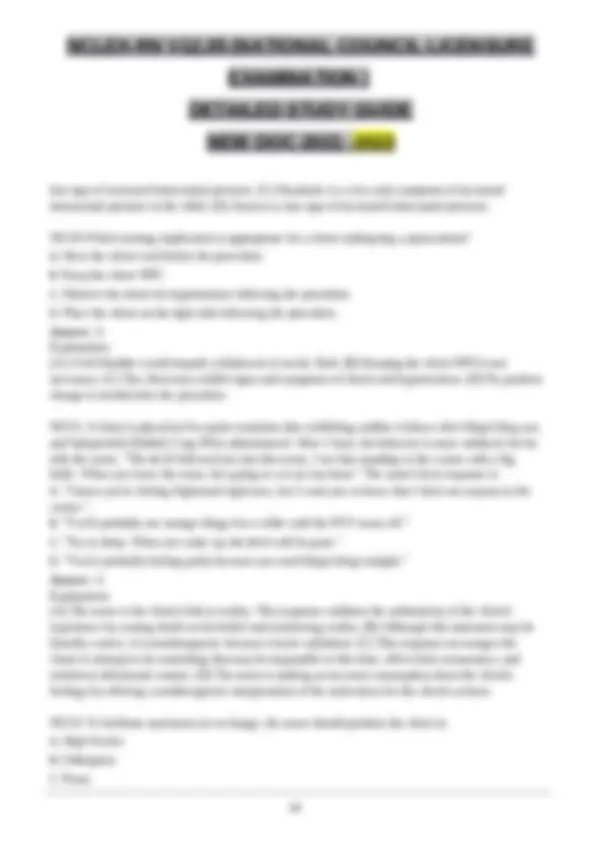
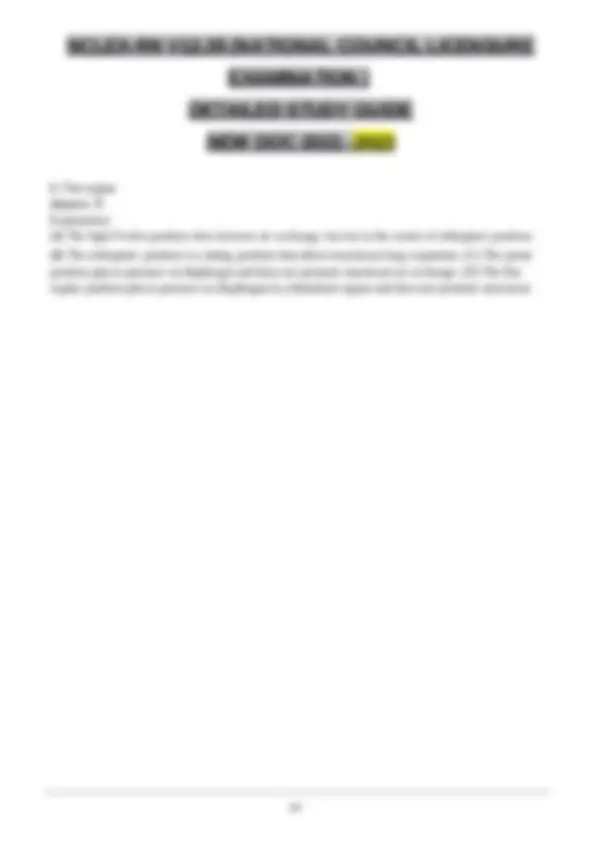
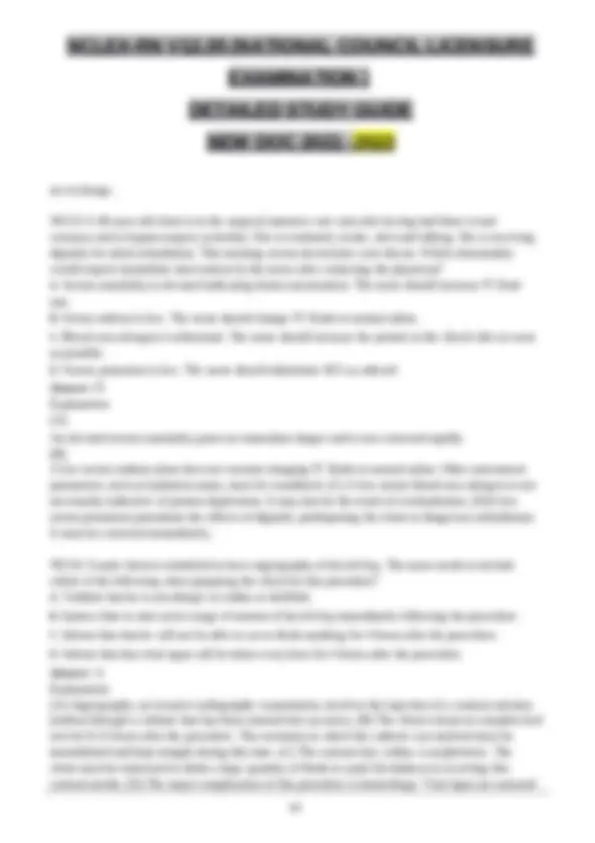
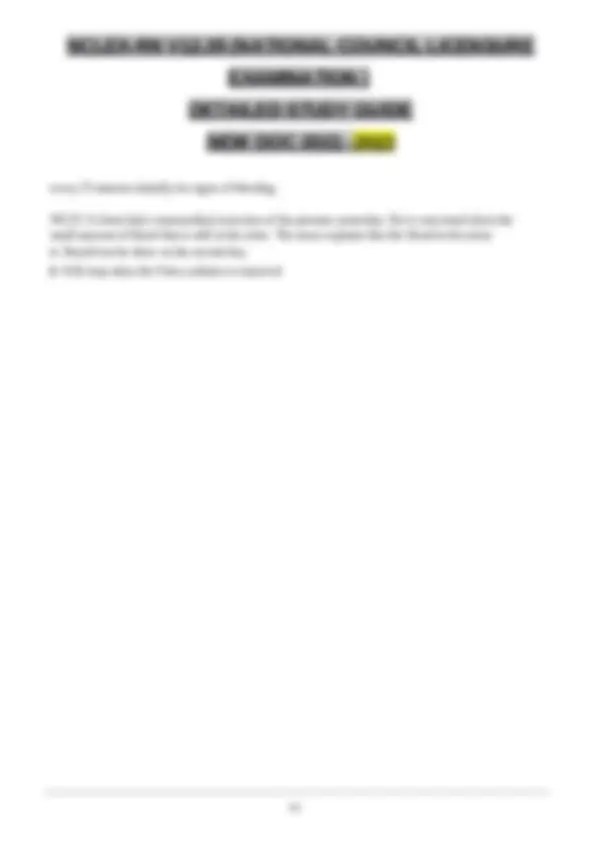
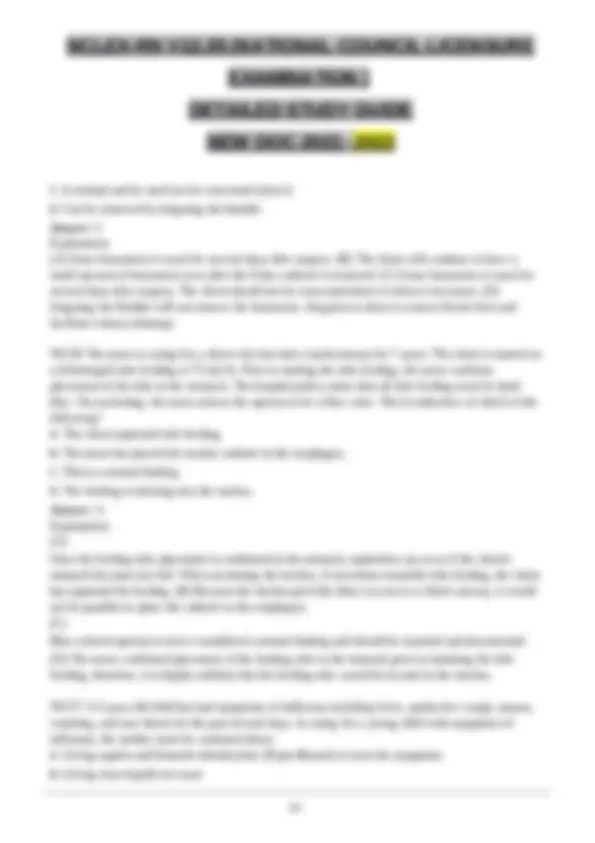
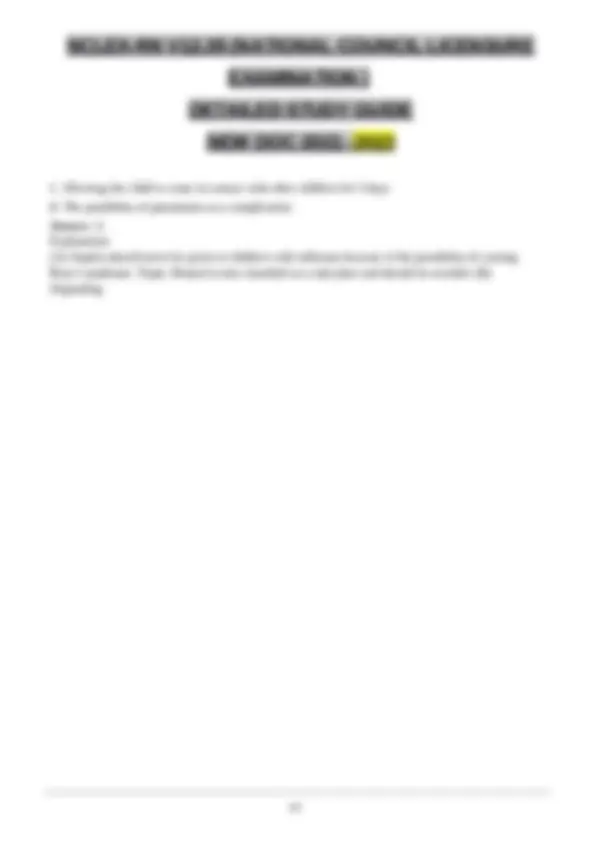
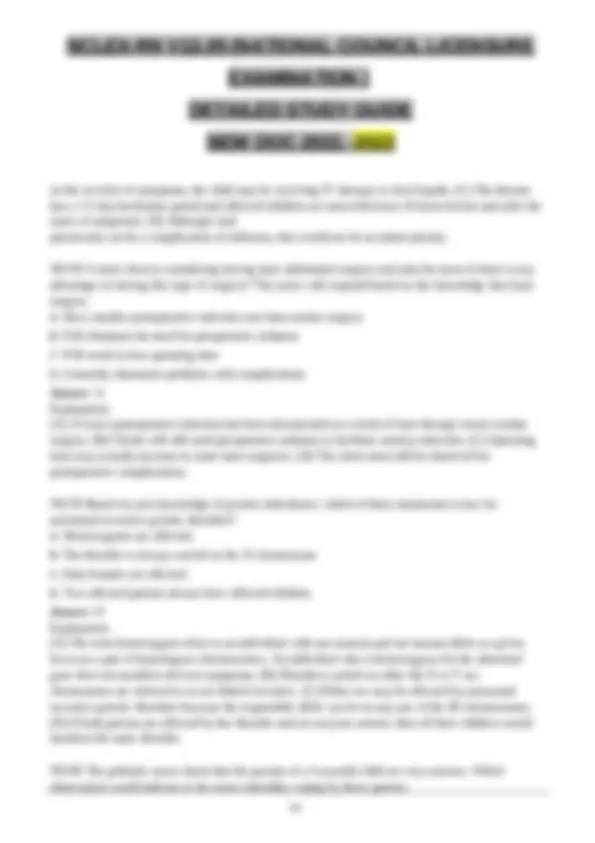
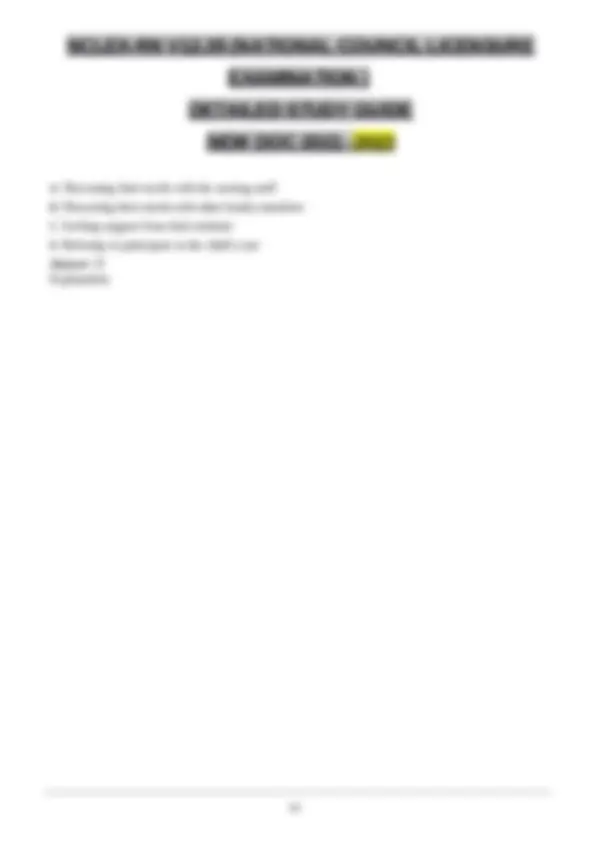
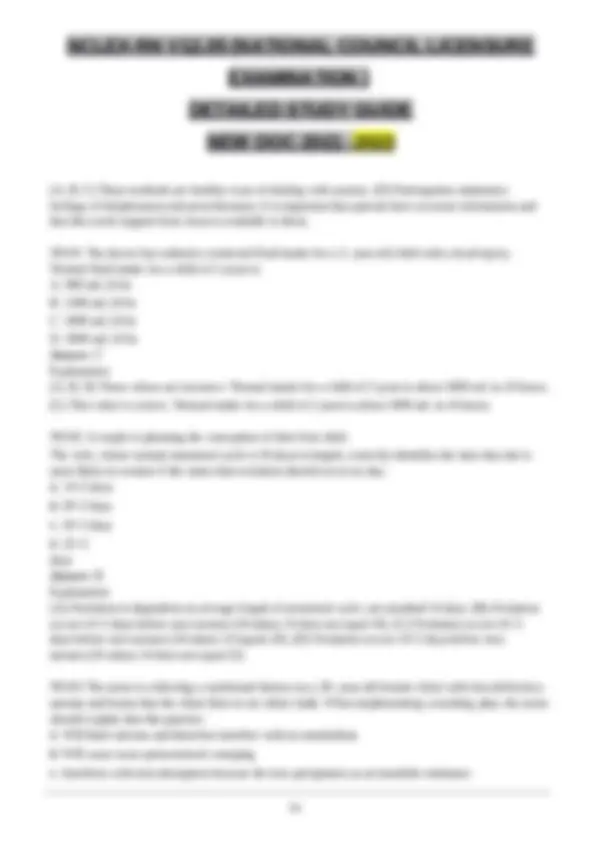
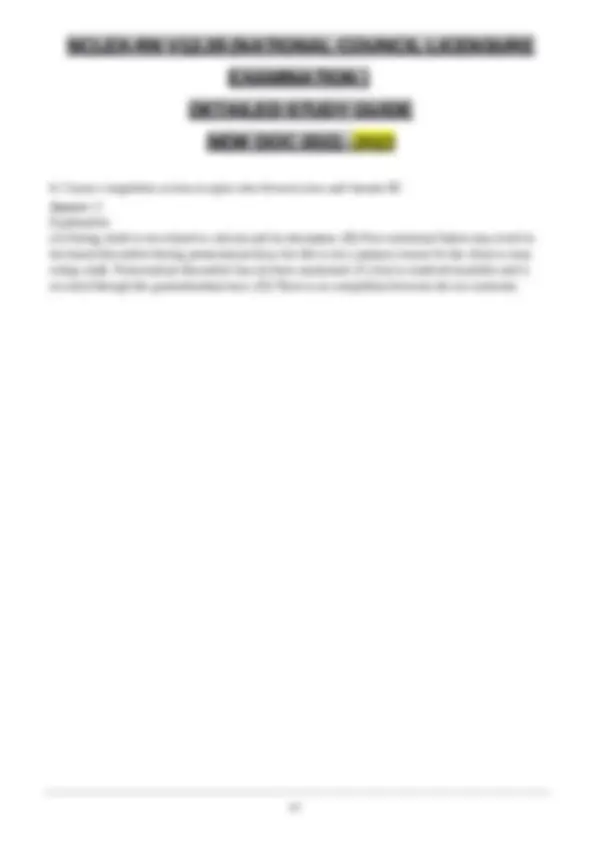
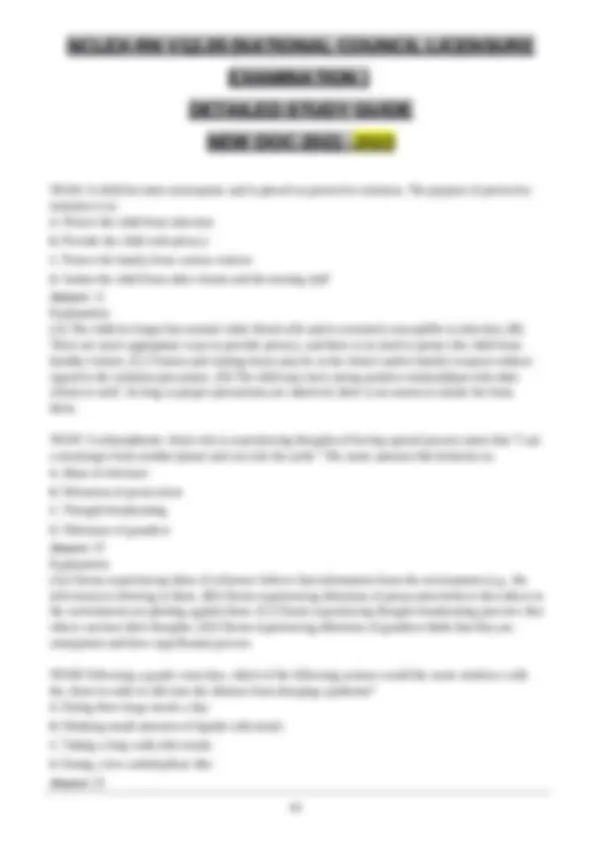
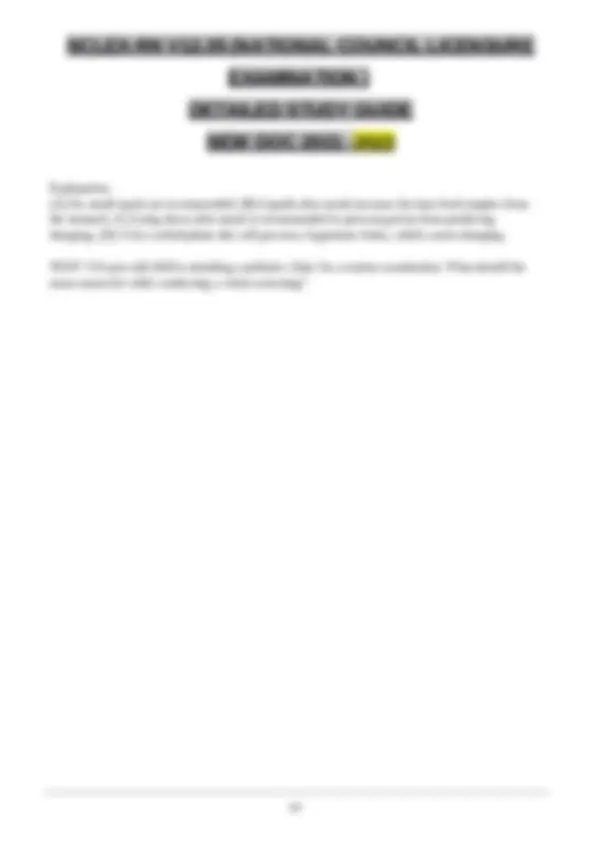
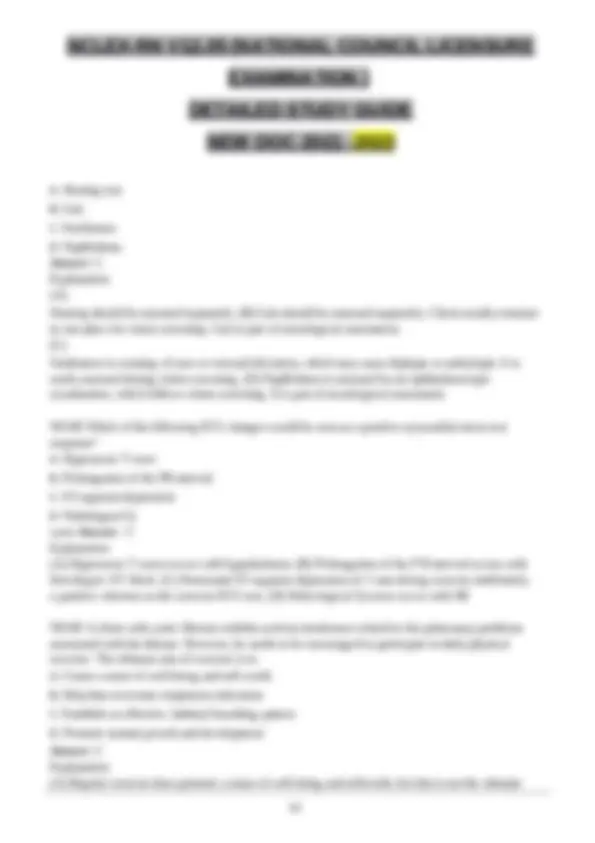
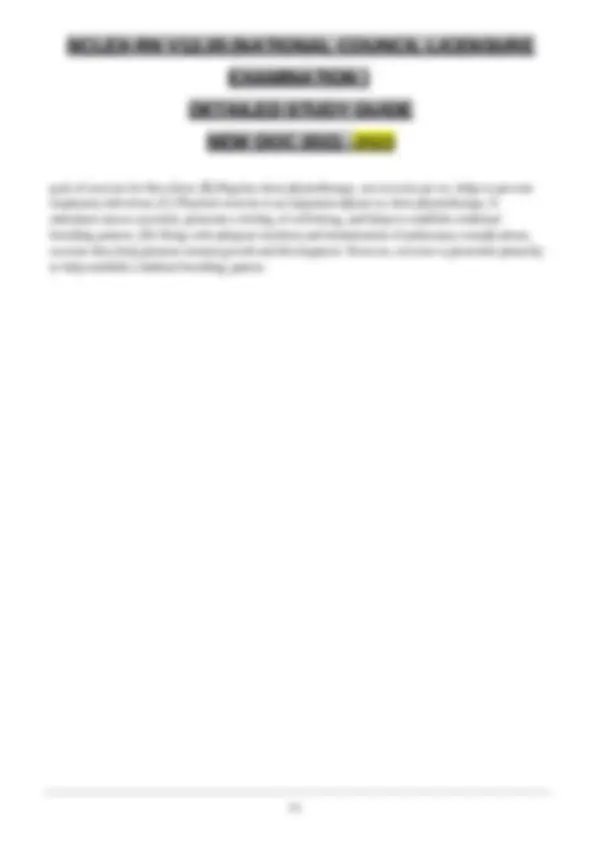
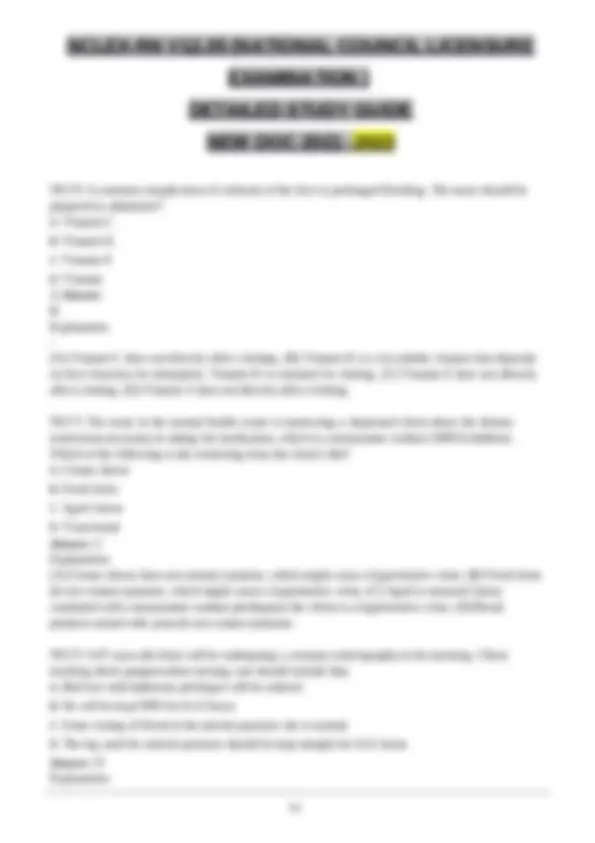
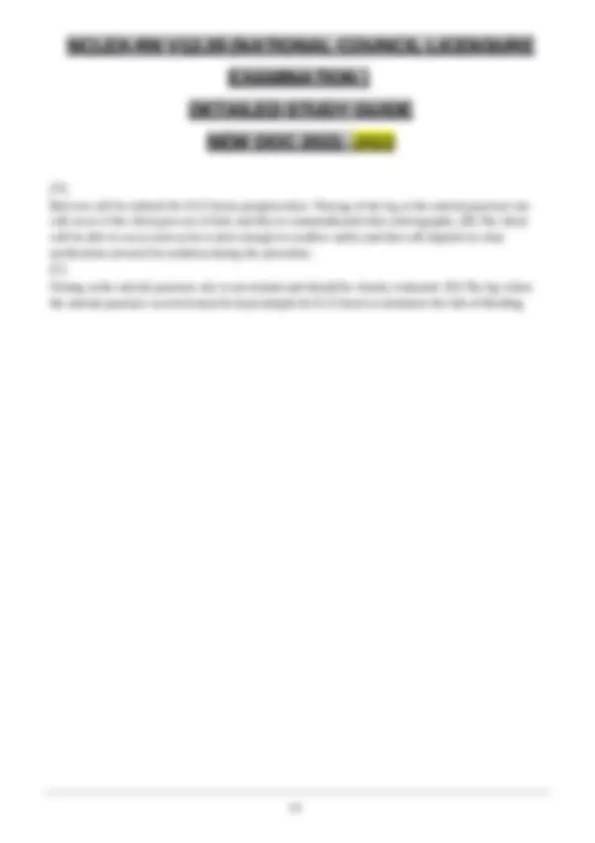
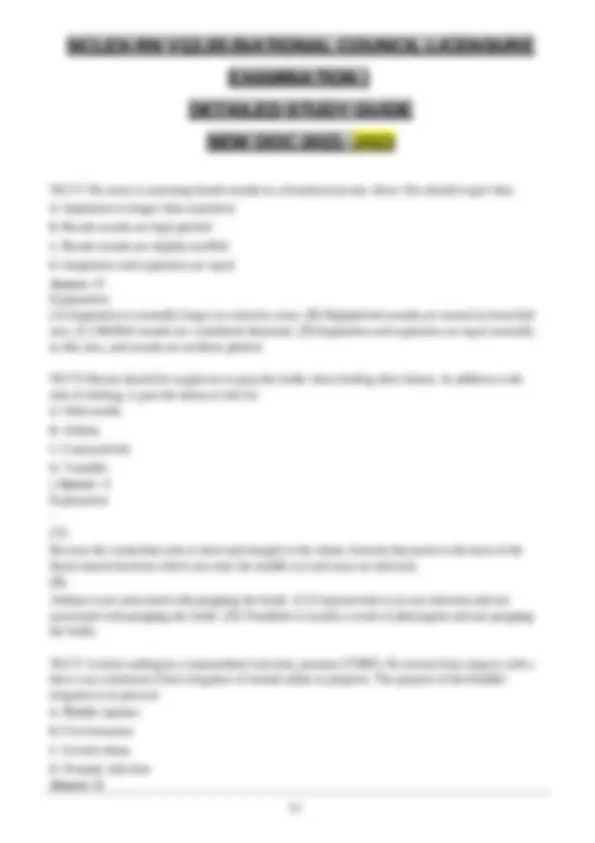
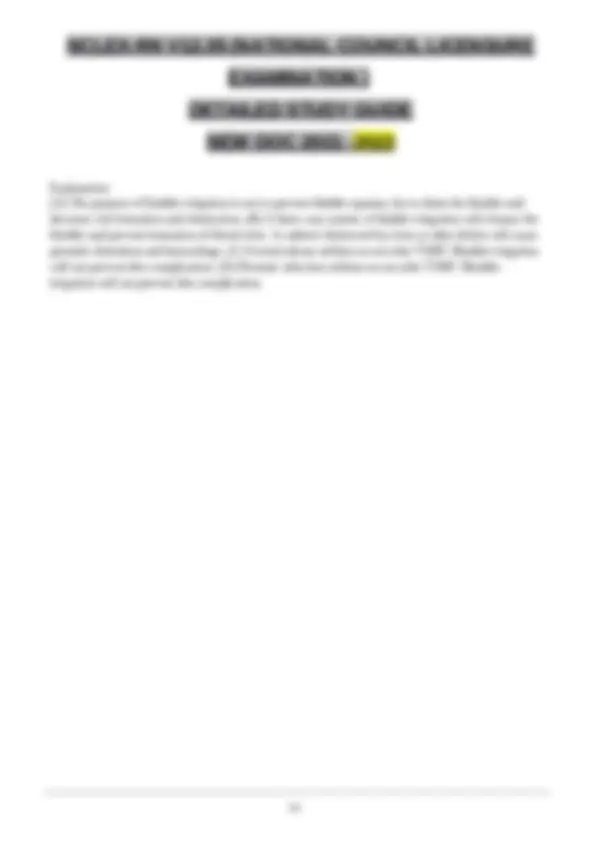
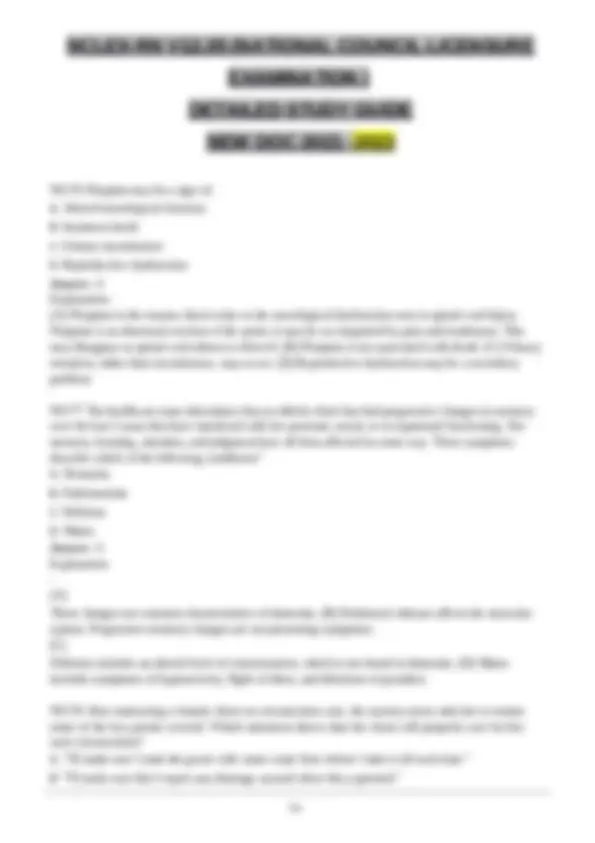
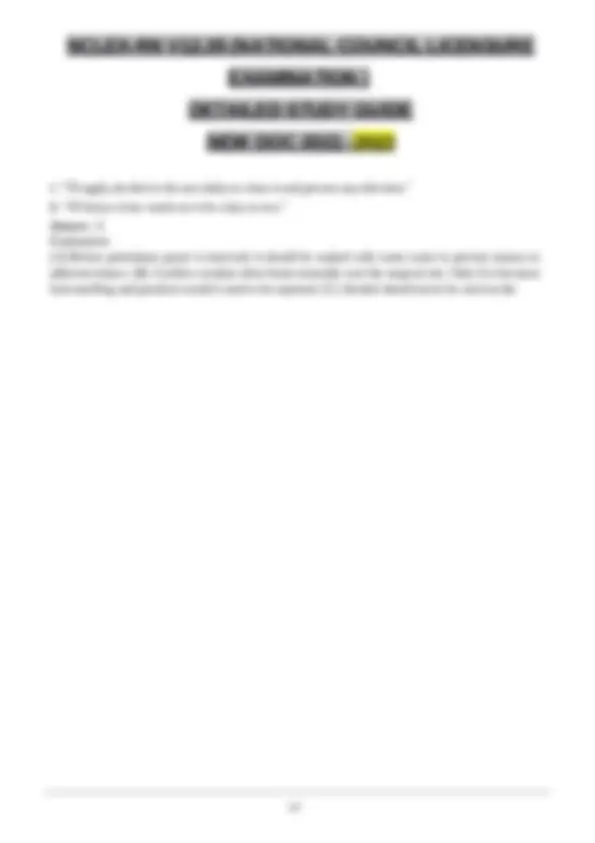
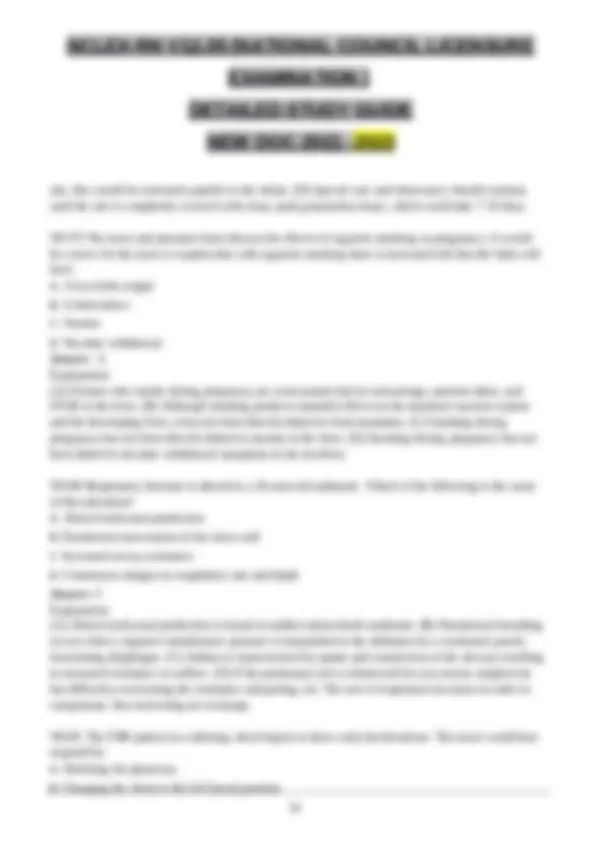
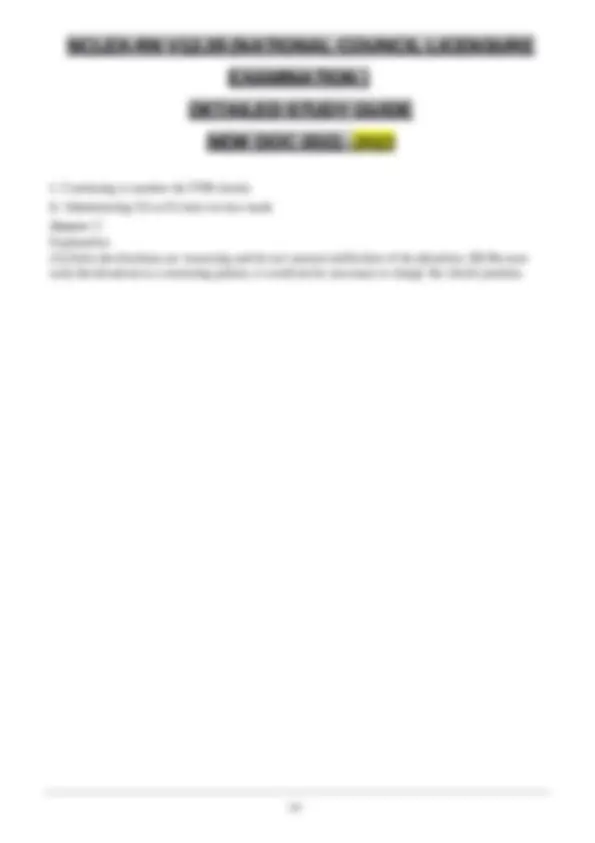
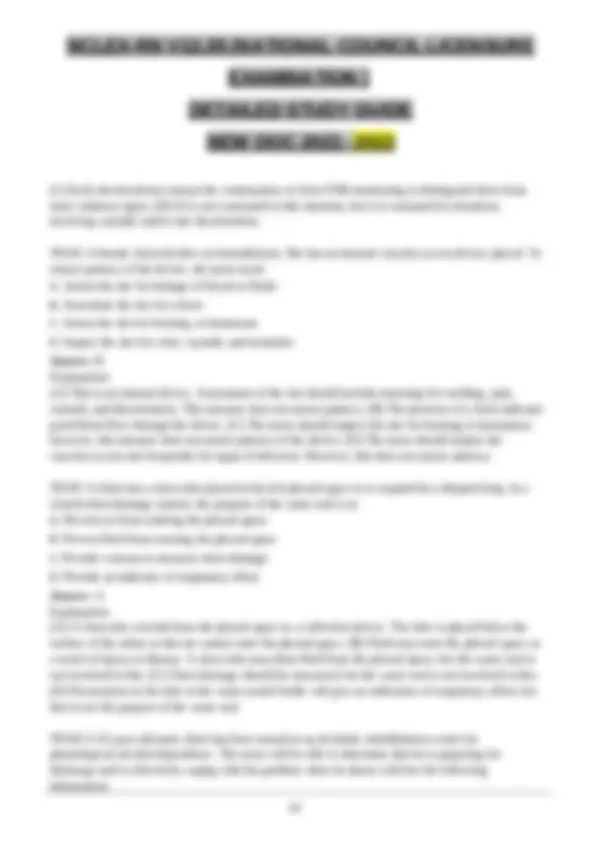
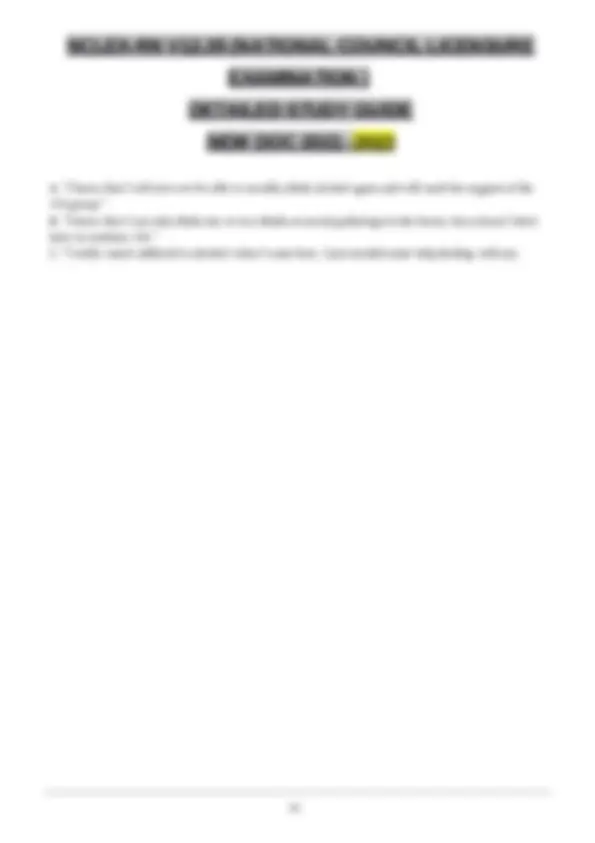
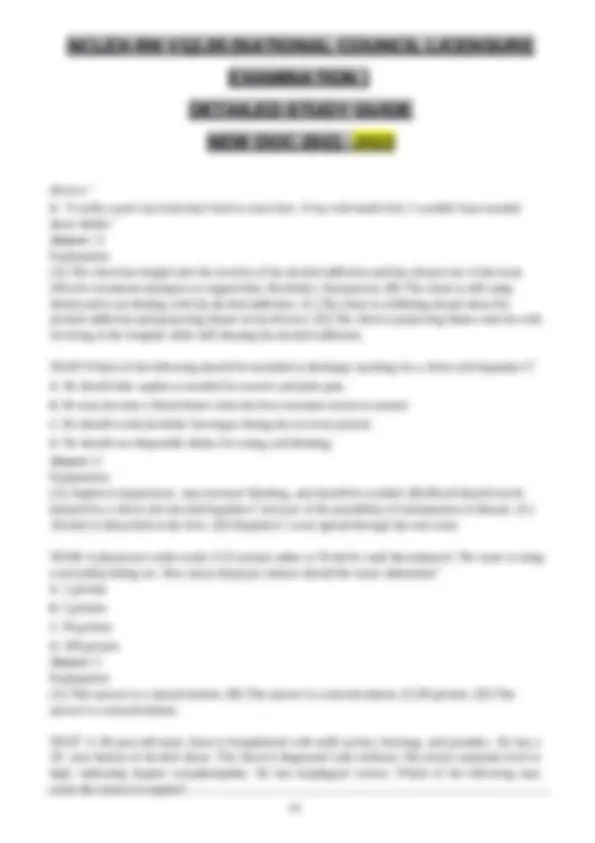
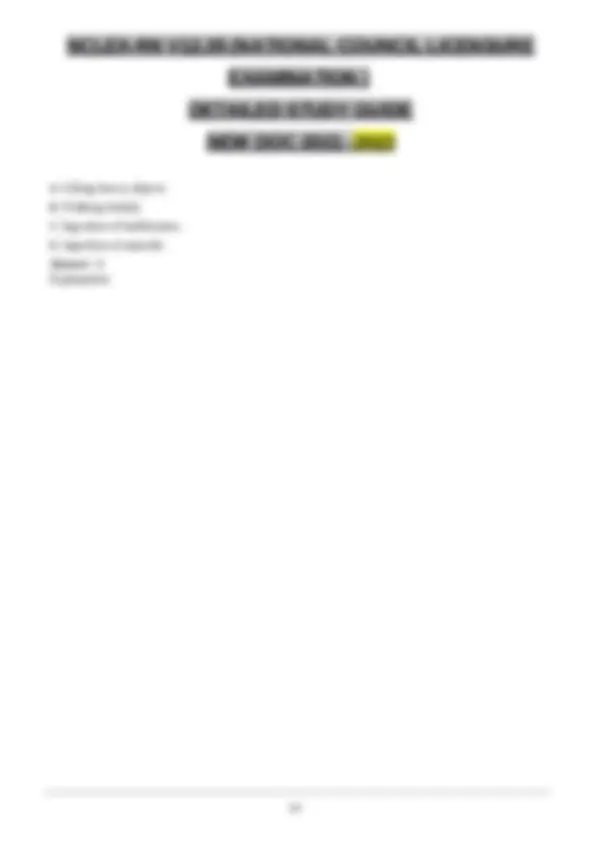
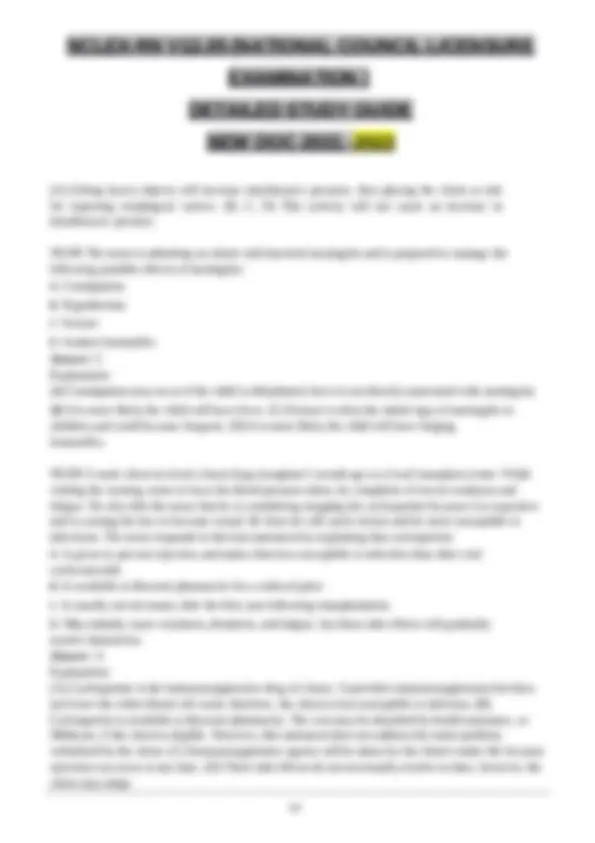
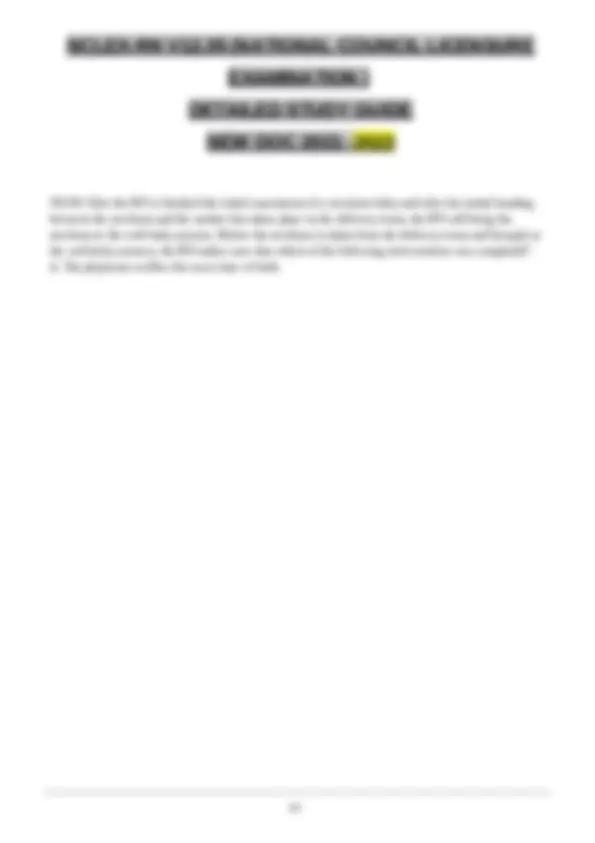
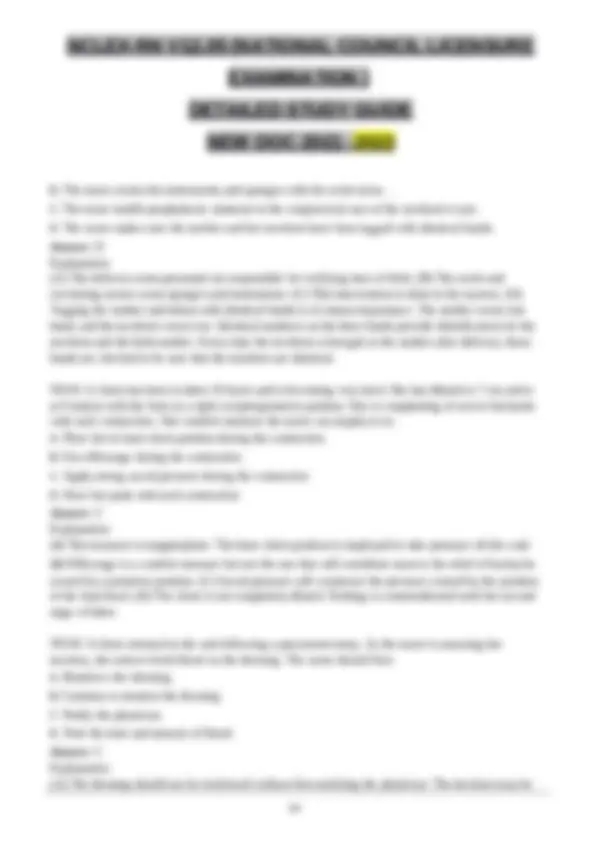
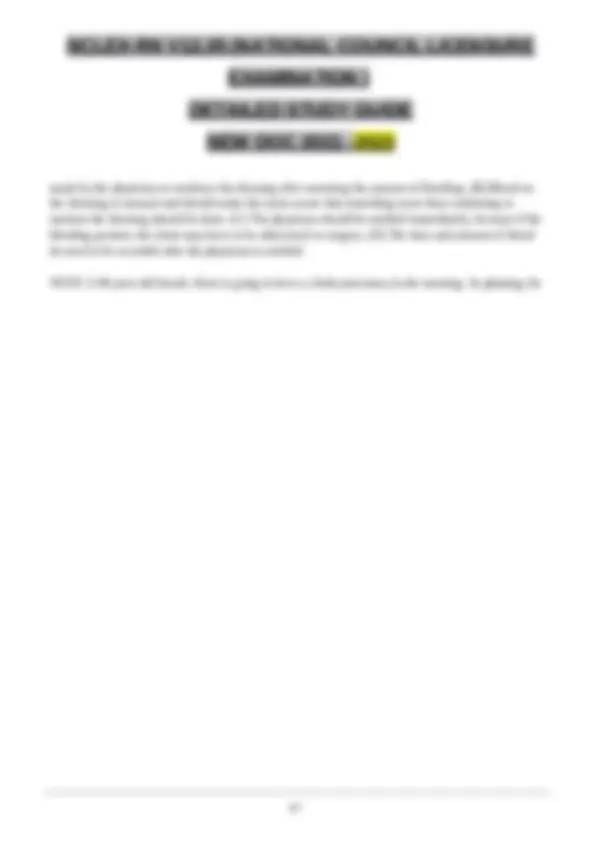
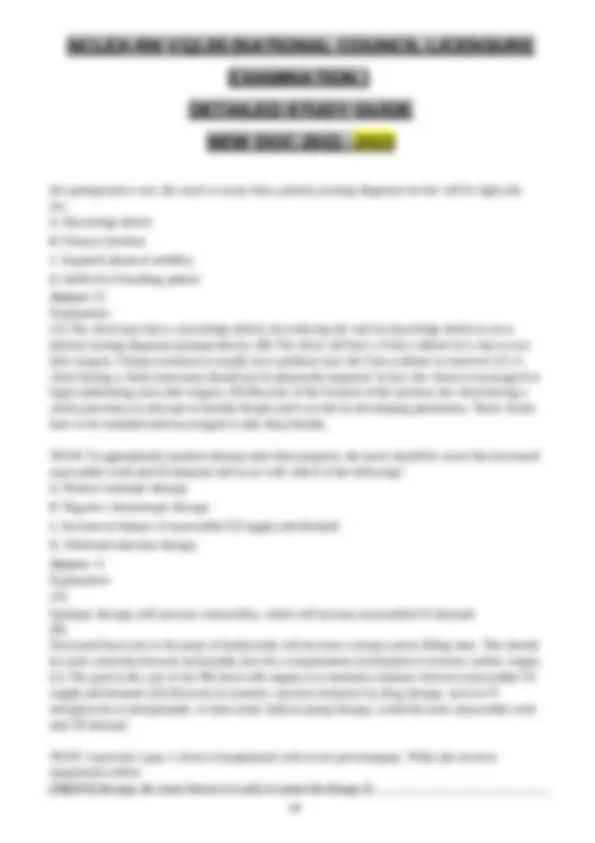

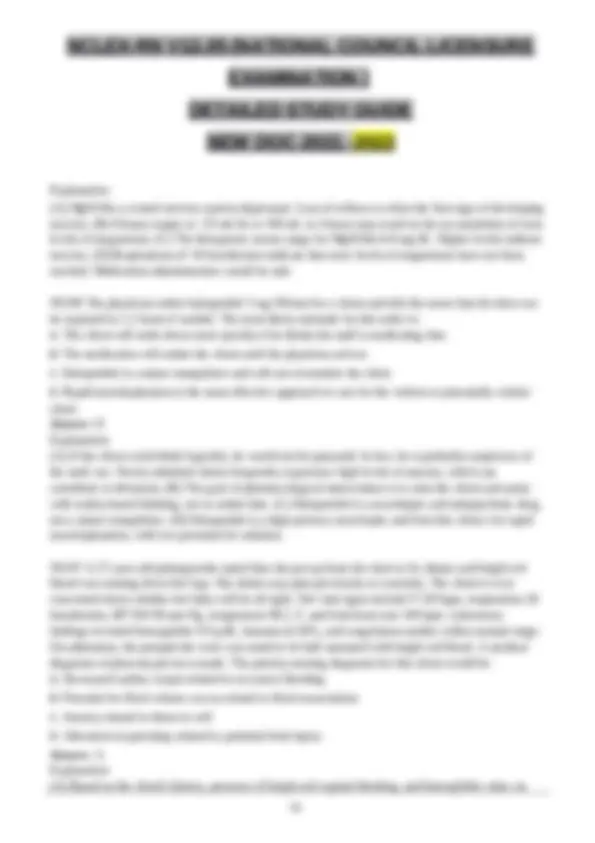
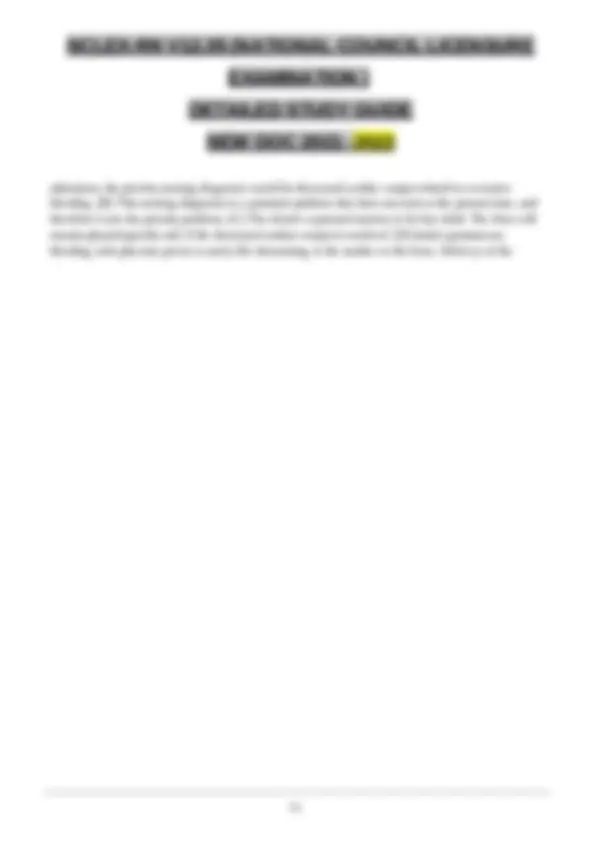
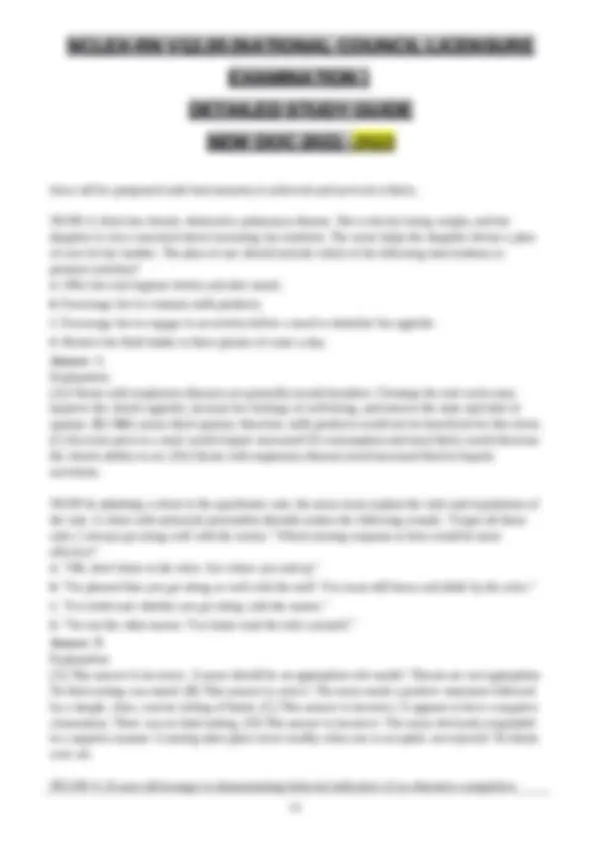
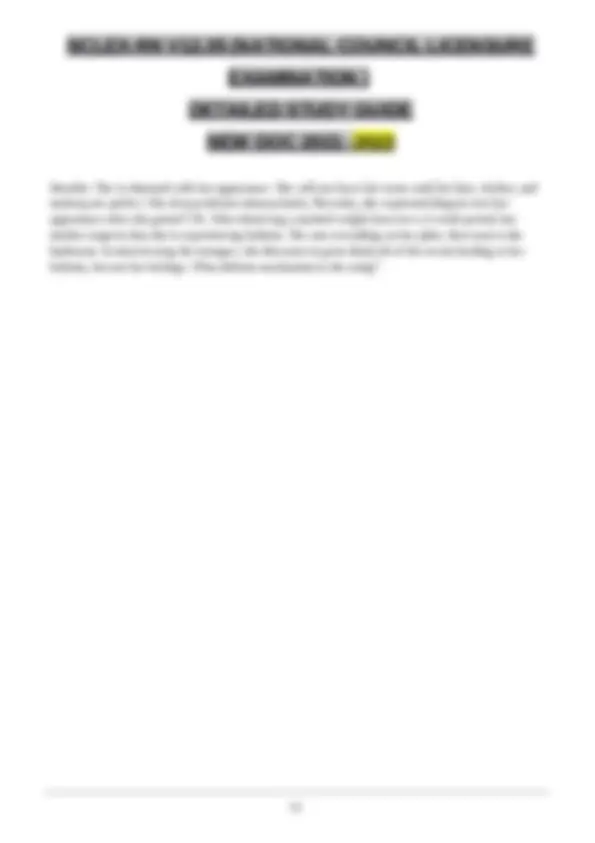
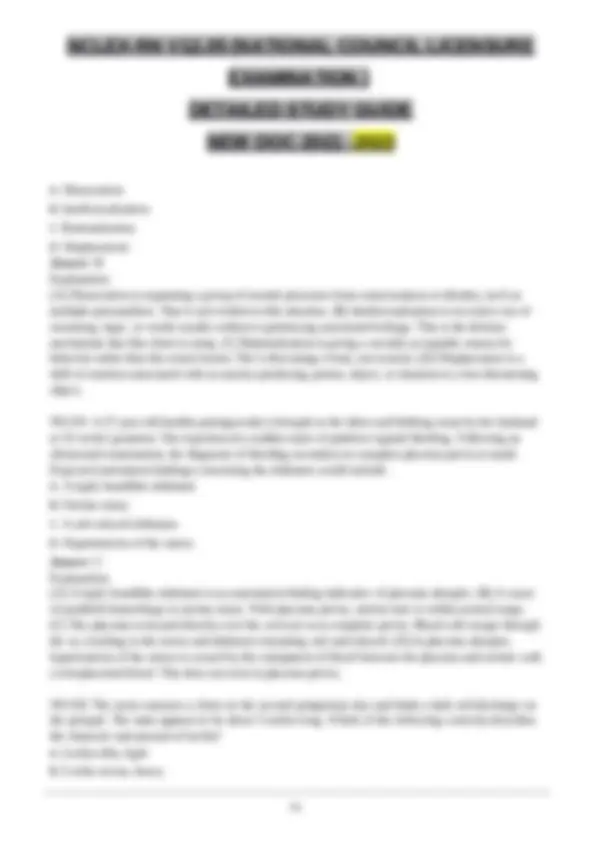
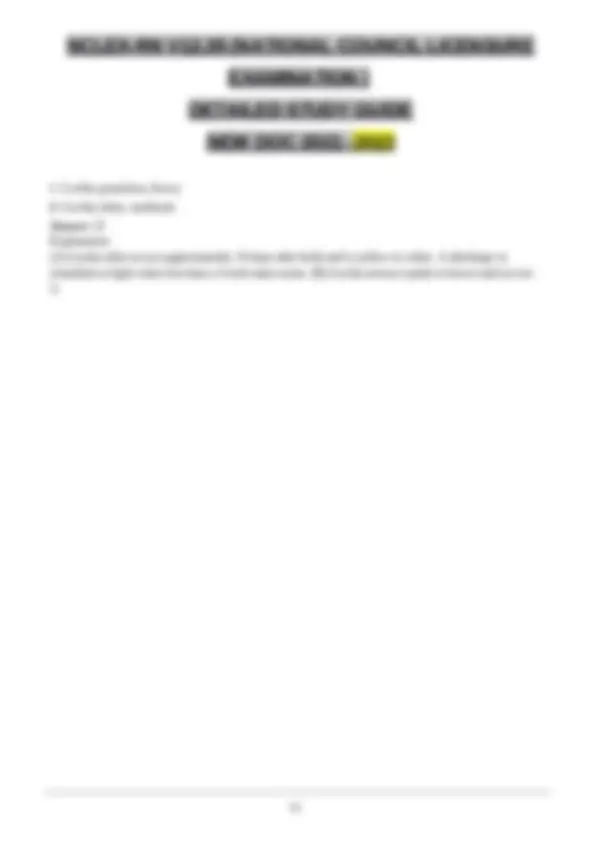
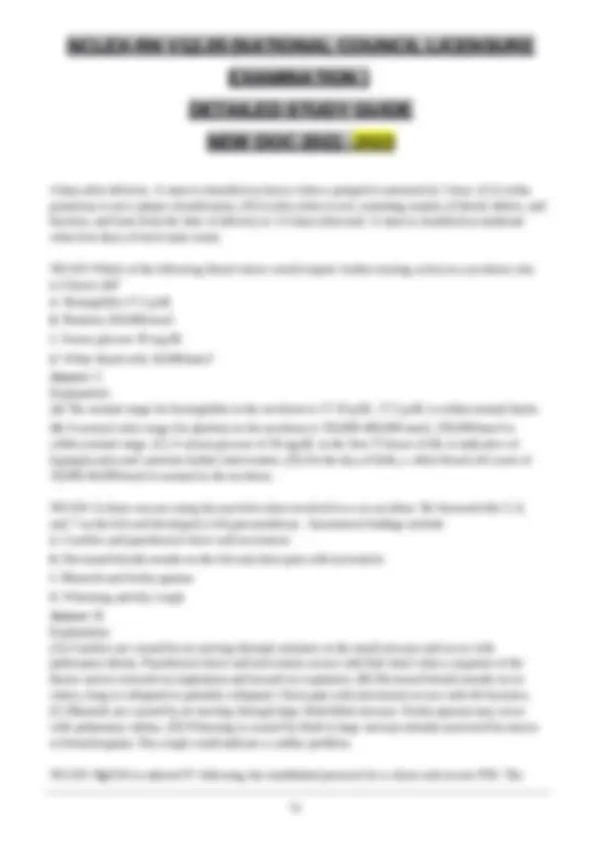

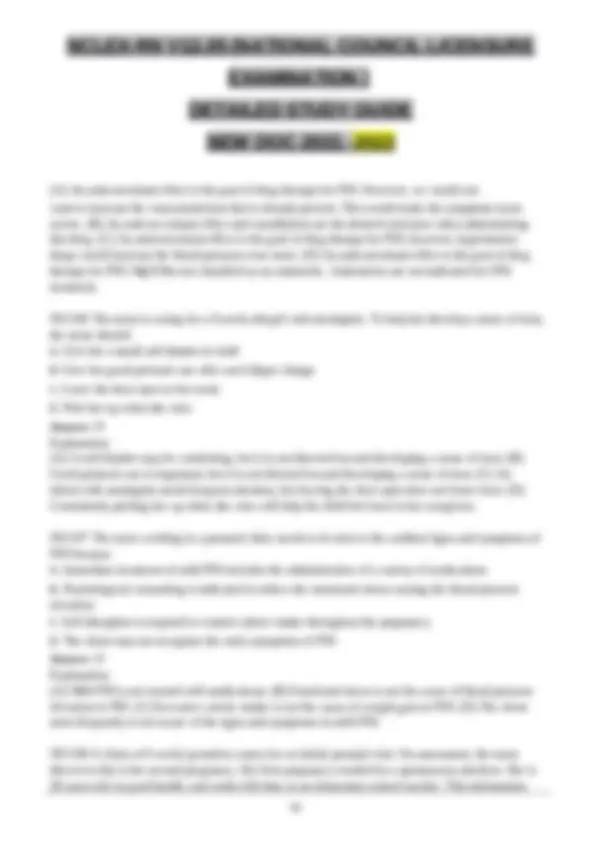
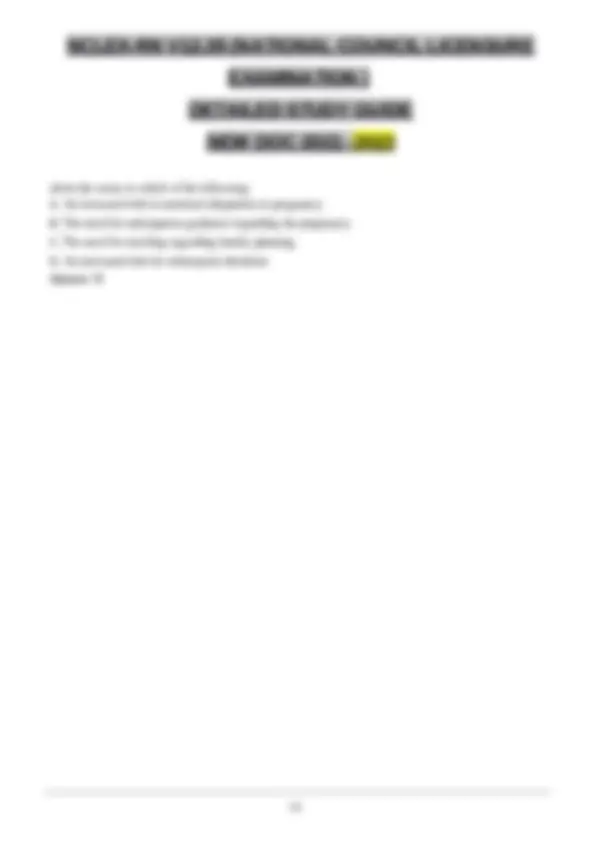
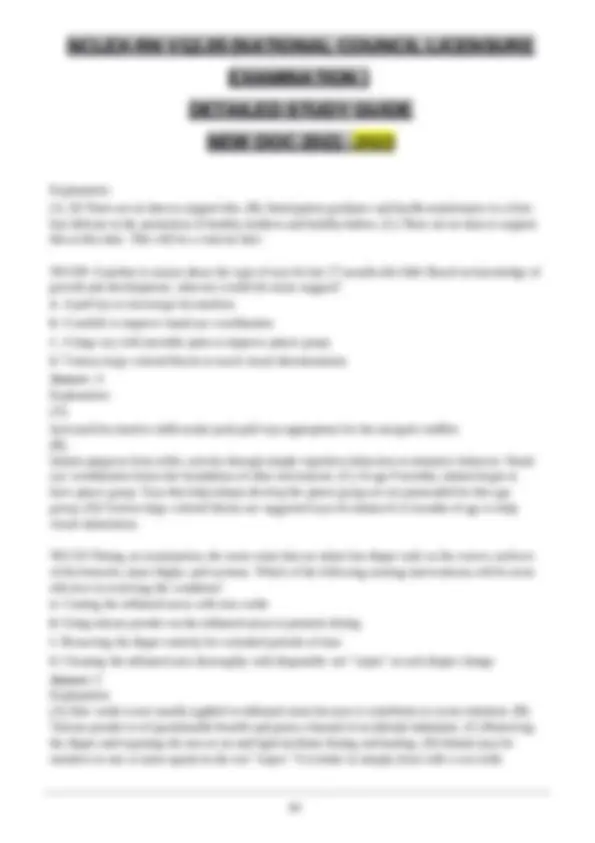
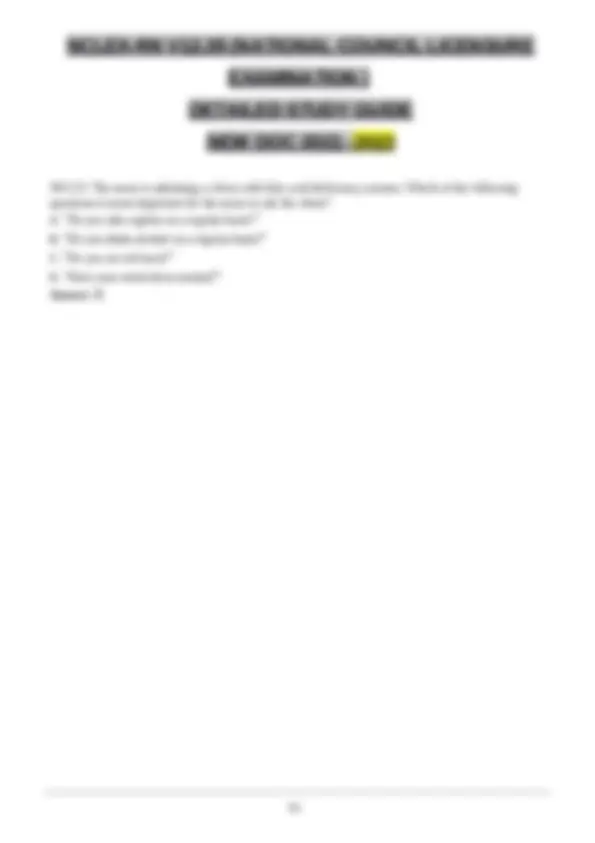
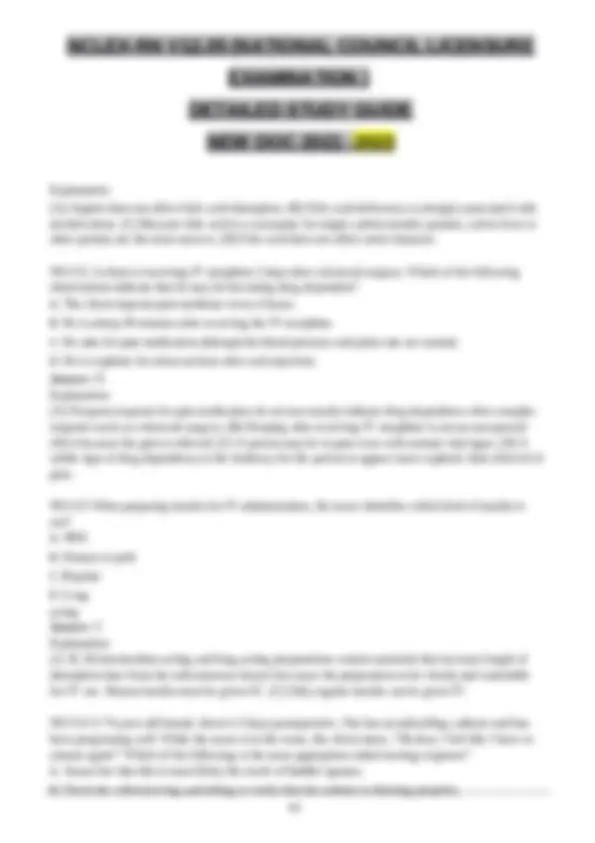
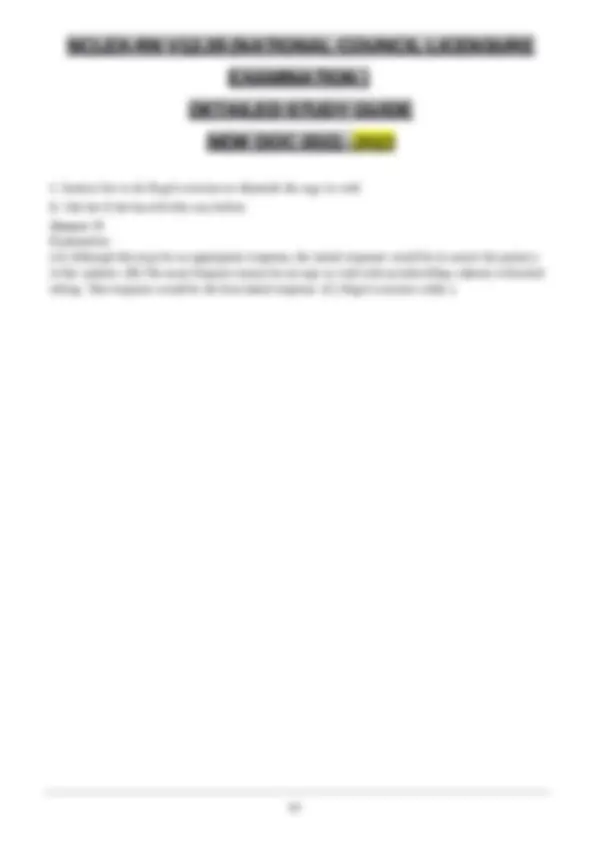
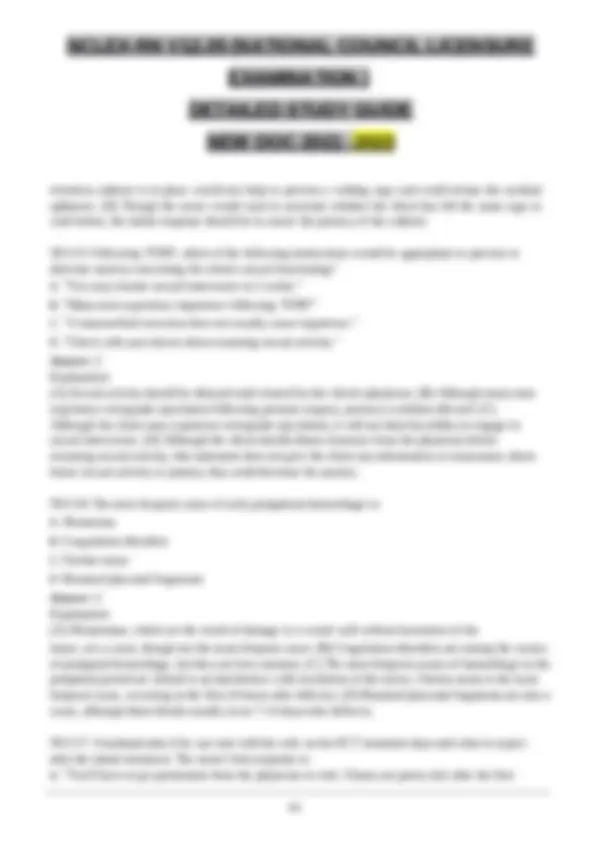
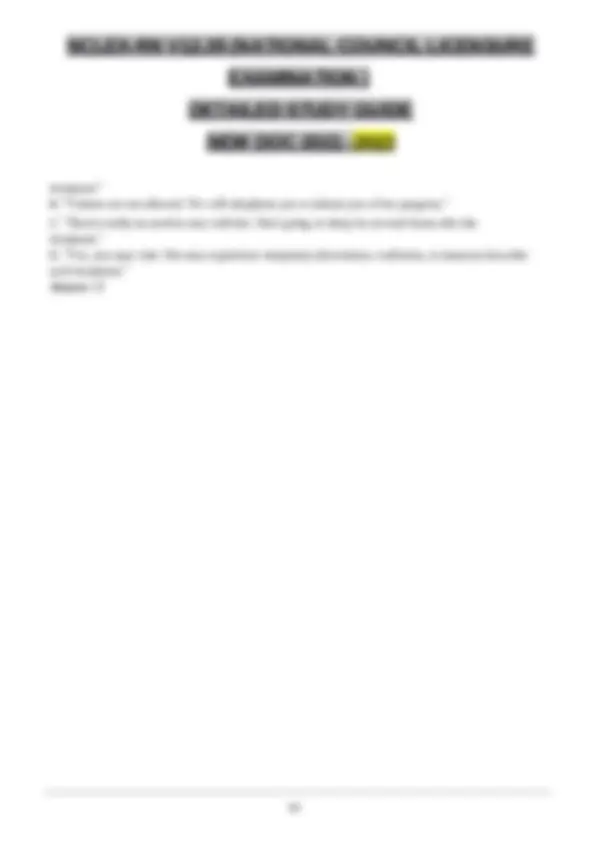
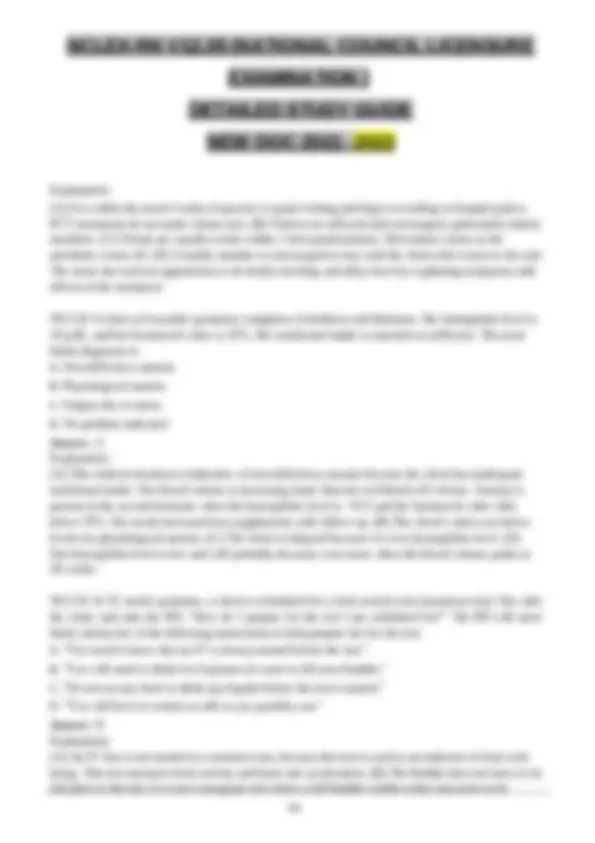
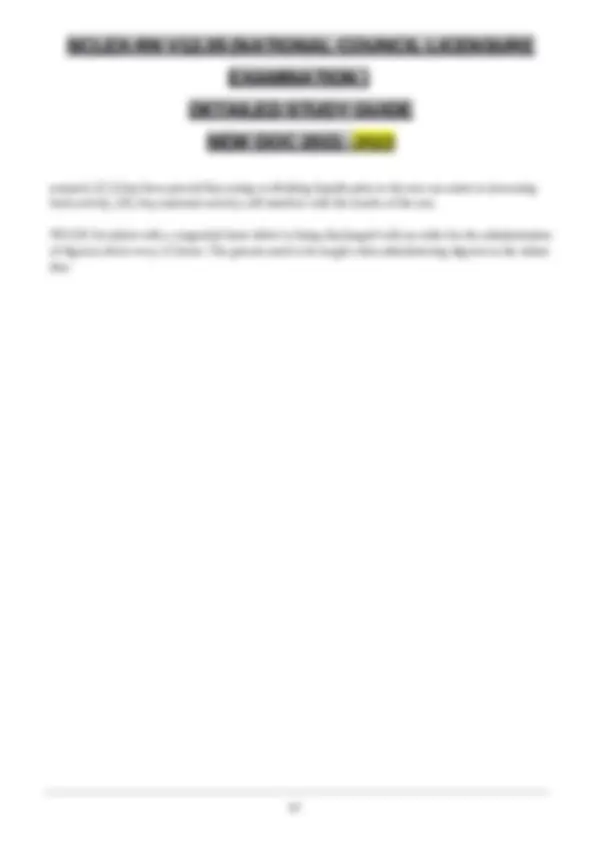
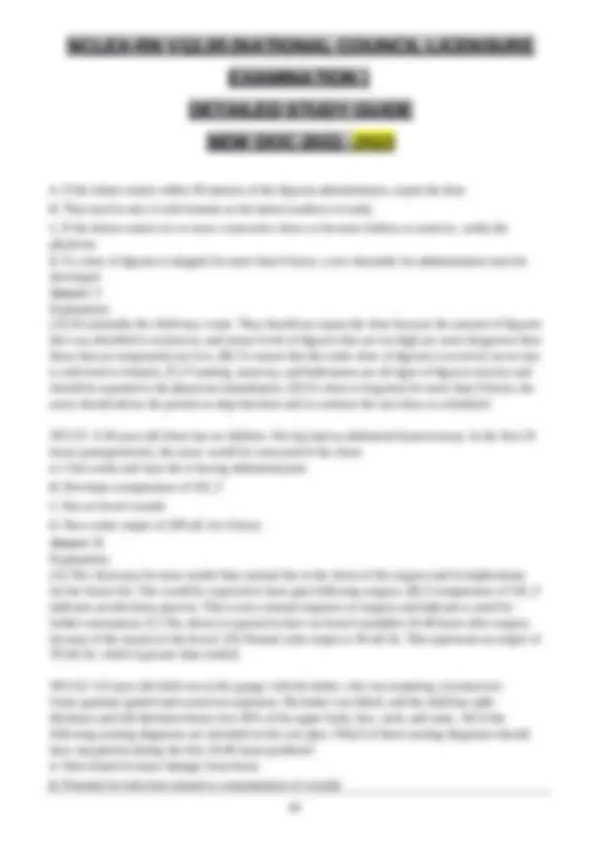

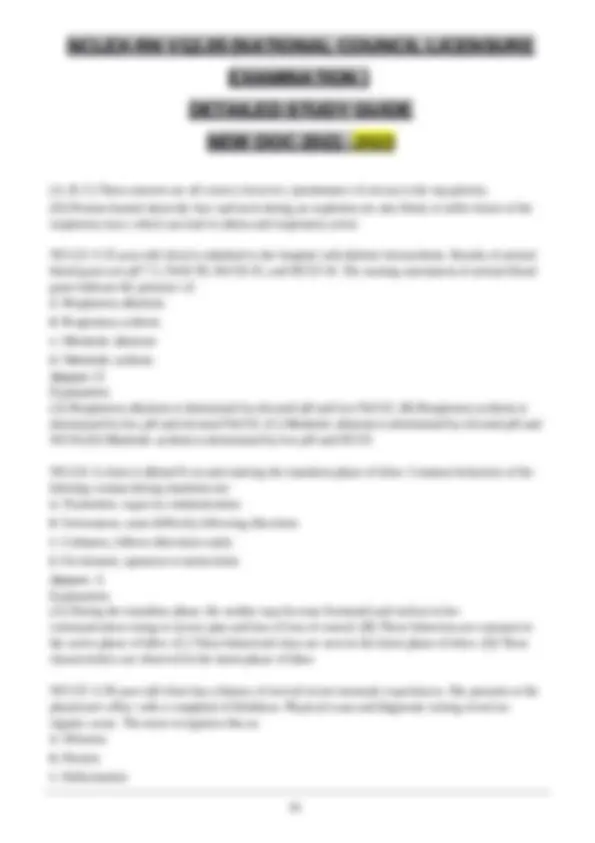
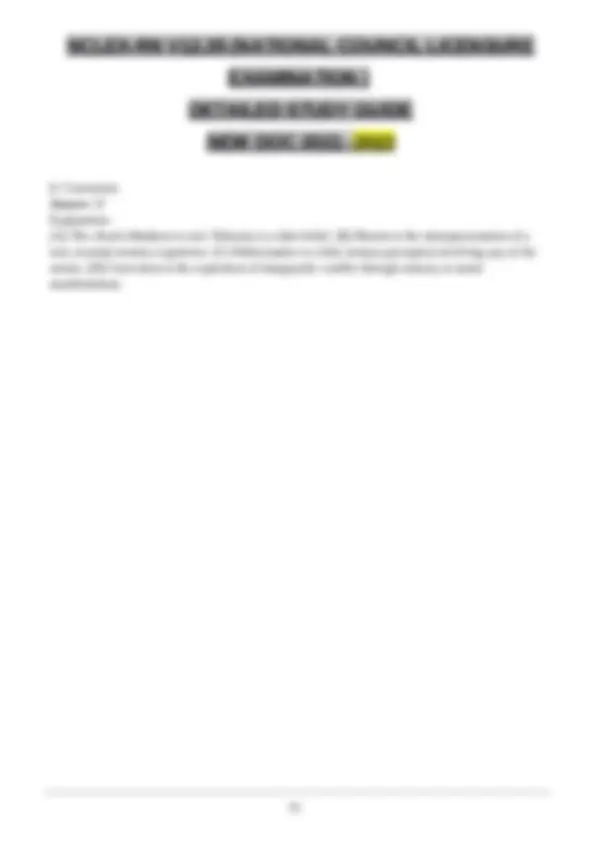
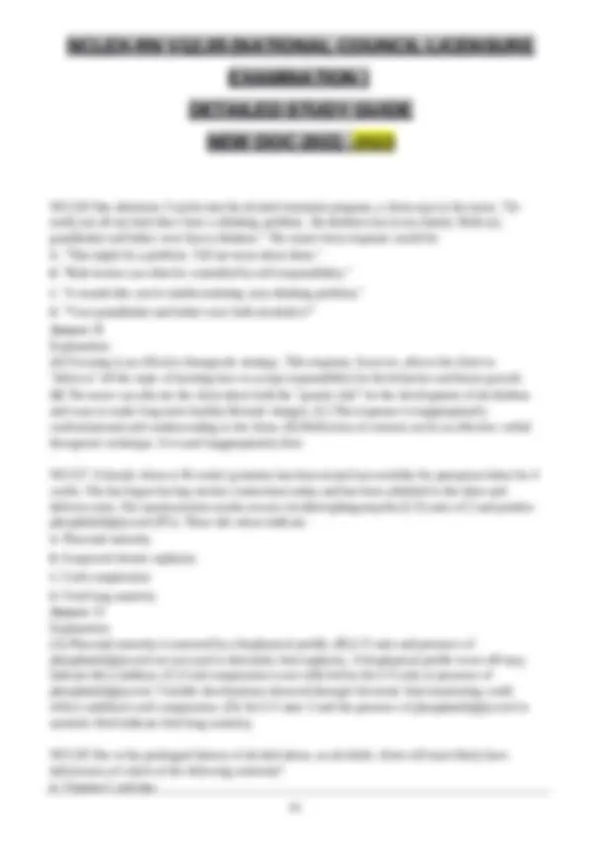
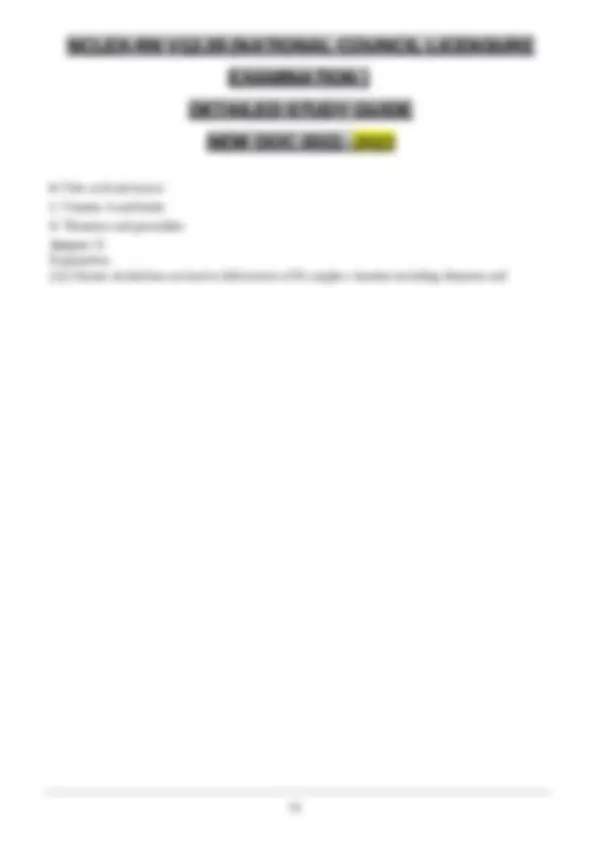
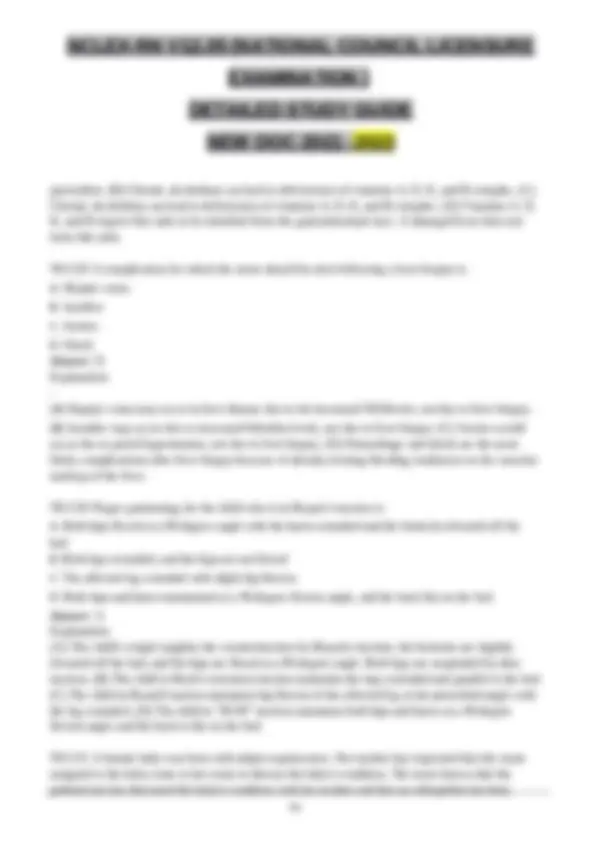
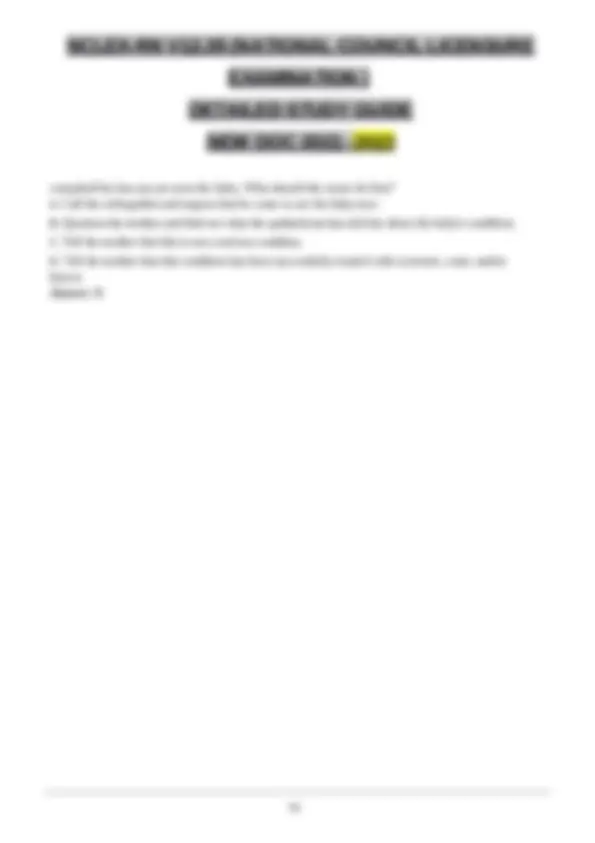
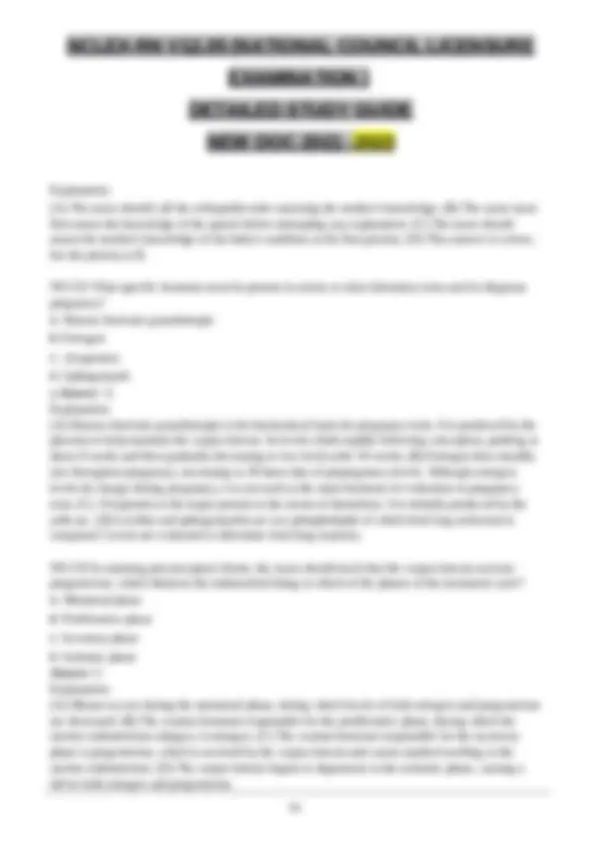
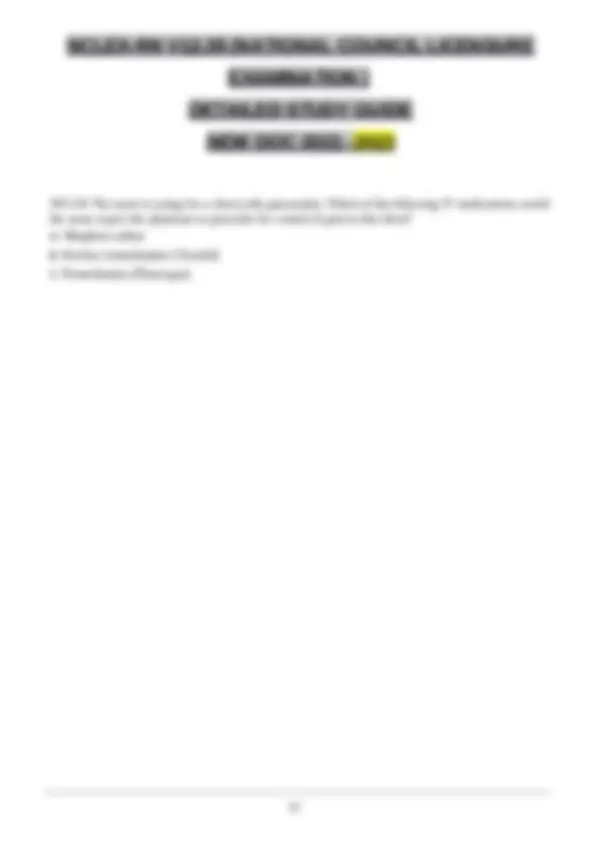
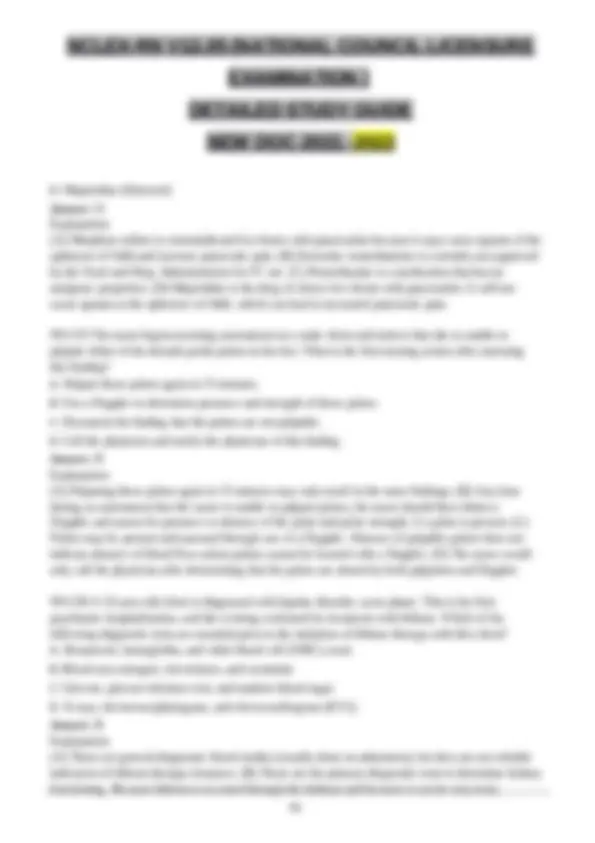
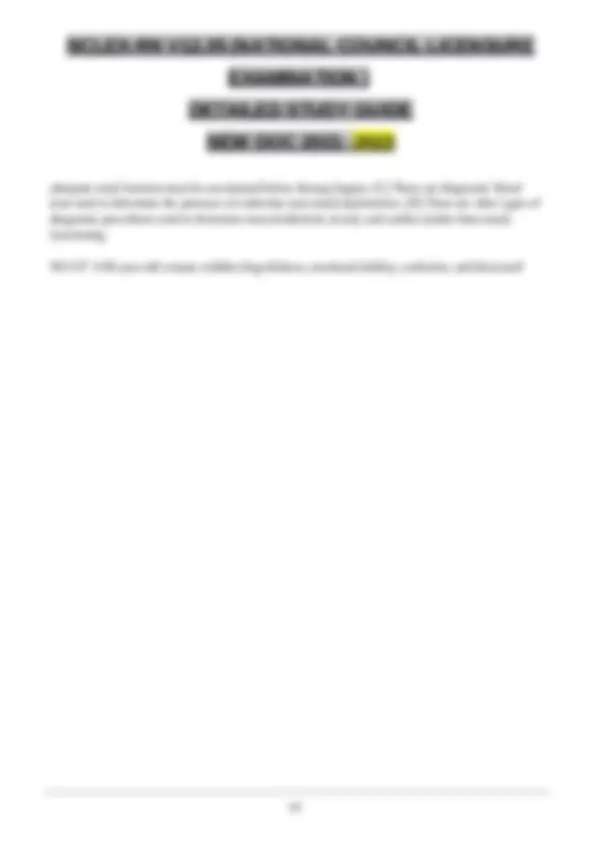
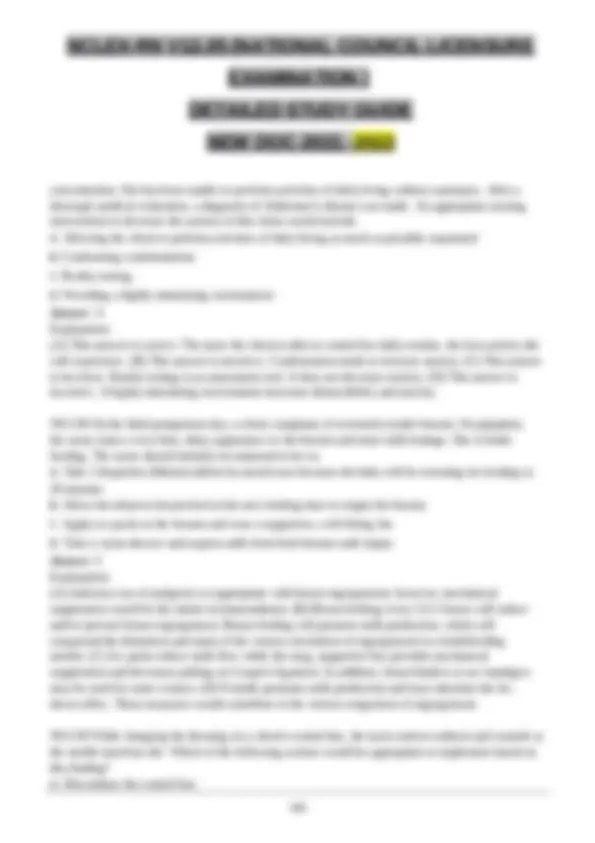


Study with the several resources on Docsity

Earn points by helping other students or get them with a premium plan


Prepare for your exams
Study with the several resources on Docsity

Earn points to download
Earn points by helping other students or get them with a premium plan
Community
Ask the community for help and clear up your study doubts
Discover the best universities in your country according to Docsity users
Free resources
Download our free guides on studying techniques, anxiety management strategies, and thesis advice from Docsity tutors
A series of nclex-rn exam questions covering various topics including fetal development, exercise, shock, and diagnoses. The questions require identifying the correct answer and explanation for each scenario.
Typology: Study notes
1 / 632

This page cannot be seen from the preview
Don't miss anything!





























































































Exam : NCLEX-RN Title : National Council Licensure Examination(NCLEX-RN) Vendor : NCLEX Version : V12.
QN 1:A depressed client is seen at the mental health center for follow-up after an attempted suicide 1 week ago. She has taken phenelzine sulfate (Nardil), a monoamine oxidase (MAO) inhibitor, for 7 straight days. She states that she is not feeling any better. The nurse explains that the drug must accumulate to an effective level before symptoms are totally relieved. Symptom relief is expected to occur within: A. 10 days B. 2-4 weeks C. 2 months D. 3 months Answer: B Explanation : (A) This answer is incorrect. It can take up to 1 month for therapeutic effect of the medication. (B) This answer is correct. Because MAO inhibitors are slow to act, it takes 2-4 weeks before improvement of symptoms is noted. (C) This answer is incorrect. It can take up to 1 month for therapeutic effect of the medication. (D) This answer is incorrect. Therapeutic effects of the medication are noted within 1 month of drug therapy. QN 2 Cystic fibrosis is transmitted as an autosomal recessive trait. This means that: A. Mothers carry the gene and pass it to their sons B. Fathers carry the gene and pass it to their daughters C. Both parents must have the disease for a child to have the disease D. Both parents must be carriers for a child to have the disease Answer: D Explanation: (A) Cystic fibrosis is not an X-linked or sex-linked disease. (B) The only characteristic on the Y chromosome is the trait for hairy ears. (C) Both parents do not need to have the disease but must be carriers. (D) If a trait is recessive, two genes (one from each parent) are necessary to produce an affected child. QN.3 A 24-year-old client presents to the emergency department protesting "I am God." The nurse identifies this as a: A. Delusion B. Illusion C. Hallucination
even a few months, to treat symptoms fully. Sometimes an antipsychotic agent is prescribed during the first few days or weeks of an acute episode to manage severe behavioral excitement and acute psychotic symptoms. In addition to the lithium, which one of the following medications might the physician prescribe? A. Diazepam (Valium) B. Haloperidol (Haldol) C. Sertraline (Zoloft) D. Alprazolam (Xanax) Answer: B Explanation: (A) Diazepam is an antianxiety medication and is not designed to reduce psychotic symptoms. (B) Haloperidol is an antipsychotic medication and may be used until the lithium takes effect. (C) Sertraline is an antidepressant and is used primarily to reduce symptoms of depression. (D) Alprazolam is an antianxiety medication and is not designed to reduce psychotic symptoms. NO.5 A violent client remains in restraints for several hours. Which of the following interventions is most appropriate while he is in restraints? A. Give fluids if the client requests them. B. Assess skin integrity and circulation of extremities before applying restraints and as they are removed. C. Measure vital signs at least every 4 hours. D. Release restraints every 2 hours for client to exercise. Answer: D Explanation: (A) Fluids (nourishment) should be offered at regular intervals whether the client requests (or refuses) them or not. (B) Skin integrity and circulation of the extremities should be checked regularly while the client is restrained, not only before restraints are applied and after they are removed. (C) Vital signs should be checked at least every 2 hours. If the client remains agitated in restraints, vital signs should be monitored even more closely, perhaps every 1-2 hours. (D) Restraints should be released every 2 hours for exercise, one extremity at a time, to maintain muscle tone, skin and joint integrity, and circulation. NO.6 The pediatrician has diagnosed tinea capitis in an 8- year-old girl and has placed her on oral griseofulvin. The nurse should emphasize which of these instructions to the mother and/or child? A. Administer oral griseofulvin on an empty stomach for best results. B. Discontinue drug therapy if food tastes funny. C. May discontinue medication when the child experiences symptomatic relief.
D. Observe for headaches, dizziness, and anorexia. Answer: D Explanation: (A) Giving the drug with or after meals may allay gastrointestinal discomfort. Giving the drug with a fatty meal (ice cream or milk) increases absorption rate. (B) Griseofulvin may alter taste sensations
NO.9 An 80-year-old male client with a history of arteriosclerosis is experiencing severe pain in his left leg that started approximately 20 minutes ago. When performing the admission assessment, the nurse would expect to observe which of the following: A. Both lower extremities warm to touch with 2_pedal pulses B. Both lower extremities cyanotic when placed in a dependent position
C. Decreased or absent pedal pulse in the left leg D. The left leg warmer to touch than the right leg Answer: C Explanation: (A) This statement describes a normal assessment finding of the lower extremities. (B) This assessment finding reflects problems caused by venous insufficiency. (C) Decreased or absentpedal pulses reflect a problem caused by arterial insufficiency. (D) The leg that is experiencing arterial insufficiency would be cool to touch due to the decreased circulation. NO.10 A 16-month-old infant is being prepared for tetralogy of Fallot repair. In the nursing assessment, which lab value should elicit further assessment and requires notification of physician? A. pH 7. B. White blood cell (WBC) count 10,000 WBCs/mm C. Hematocrit 60% D. Bleeding time of 4 minutes Answer: C Explanation: (A) Normal pH of arterial blood gases for an infant is 7.35-7.45. (B) Normal white blood cell count in an infant is 6,000-17,500 WBCs/mm3. (C) Normal hematocrit in infant is 28%-42%. A 60% hematocrit may indicate polycythemia, a common complication of cyanotic heart disease. (D) Normal bleeding time is 2-7 minutes. NO.11 A male client is experiencing extreme distress. He begins to pace up and down the corridor. What nursing intervention is appropriate when communicating with the pacing client? A. Ask him to sit down. Speak slowly and use short, simple sentences. B. Help him to recognize his anxiety. C. Walk with him as he paces. D. Increase the level of his supervision. Answer: C Explanation: (A) The nurse should not ask him to sit down. Pacing is the activity he has chosen to deal with his anxiety. The nurse dealing with this client should speak slowly and with short, simplesentences. (B) The client may already recognize the anxiety and is attempting to deal with it. (C) Walk with the client as he paces. This gives support while he uses anxiety-generated energy. (D) Increasing the level of supervision may be appropriate after he stops pacing. It would minimize self-injury and/or loss of control.
Explanation: (A) Amniocentesis can be performed to assess for lung maturity. Fetal ultrasound can be used for gestational dating, although it does not separately determine lung maturity. (B) Ultrasound can evaluate amniotic fluid volume, which may be used to determine congenital anomalies. (C) Amniocentesis involves removal of amniotic fluid for evaluation. The needle, inserted through the abdomen, is guided by ultrasound to avoid needle injuries, and the test evaluates the position of the placenta and the fetus. (D) Amniocentesis can be performed as early as the 15th-17th week of pregnancy. NO.13 A 25-year-old client believes she may be pregnant with her first child. She schedules an obstetric examination with the nurse practitioner to determine the status of her possible pregnancy. Her last menstrual period began May 20, and her estimated date of confinement using Nagele's rule is: A. March 27 B. February 1 C. February 27 D. January 3 Answer: C Explanation : (A)March 27 is a miscalculation. (B) February 1 is a miscalculation. (C) February 27 is the correct answer. To calculate the estimated date of confinement using Nagele's rule, subtract 3 months from the date that the last menstrual cycle began and then add 7 days to the result. (D) January 3 is a miscalculation. NO.14 A client is now pregnant for the second time. Her first child weighed 4536 g at delivery. The client's glucose tolerance test shows elevated blood sugar levels. Because she only shows signs of diabetes when she is pregnant, she is classified as having: A. Insulin-dependent diabetes B. Type II diabetes mellitus C. Type I diabetes mellitus D. Gestational diabetes mellitus Answer: D Explanation: (A) Insulin-dependent diabetes mellitus, also known as type I diabetes, usually appears before the age of 30 years with an abrupt onset of symptoms requiring insulin for management. It is not related to onset during pregnancy. (B) Non-insulin-dependent diabetes (type II diabetes) usually appears in older adults. It has a slow onset and progression of symptoms. (C) This type of diabetes is the same as
insulin-dependent diabetes. (D) Gestational diabetes mellitus has its onset of symptoms during pregnancy and usually disappears after delivery. These symptoms are usually mild and not life threatening, although they are associated with increased fetal morbidity and other fetal complications. NO.15 A 44-year-old female client is receiving external radiation to her scapula for metastasis of
A. Providing him with books, challenging puzzles, and games as diversionary activities B. Allowing him to do as much for himself as he is able, including learning to do pin-site care under supervision C. Having a volunteer come in to sit with the client and to read him stories D. Stimulating rest and relaxation by gentle rubbing with lotion and changing the client's position frequently Answer: B
Explanation: (A) These activities could be frustrating for the client if he is having difficulty with problem solving and concentration. (B) Selfcare is usually well received by the child, and it is one of the most useful interventions to help the child cope with immobility. (C) This may be helpful to the client if he has no visitors, but it does little to help him develop coping skills. (D) This will helpto prevent skin irritation or breakdown related to immobility but will not help to prevent behavioral changes related to immobility. NO.18 In client teaching, the nurse should emphasize that fetal damage occurs more frequently with ingestion of drugs during: A. First trimester B. Second trimester C. Third trimester D. Every trimester Answer: A Explanation: (A) Organogenesis occurs in the first trimester. Fetus is most susceptible to malformation during this period. (B) Organogenesis has occurred by the second trimester. (C) Fetal development is complete by this time. (D) The dangerous period for fetal damage is the first trimester, not the entire pregnancy. NO.19 On admission, the client has signs and symptoms of pulmonary edema. The nurse places the client in the most appropriate position for a client in pulmonary edema, which is: A. High Fowler B. Lying on the left side C. Sitting in a chair D. Supine with feet elevated Answer: A Explanation: (A) High Fowler position decreases venous return to the heart and permits greater lung expansion so that oxygenation is maximized. (B) Lying on the left side may improve perfusion to the left lung but does not promote lung expansion. (C) Sitting in a chair will decrease venous return and promote maximal lung expansion. However, clients with pulmonary edema can deteriorate quickly and require intubation and mechanical ventilation. If a client is sitting in achair when this deterioration happens, it will be difficult to intervene quickly. (D) The supine with feet elevated position increases venous return and will worsen pulmonary edema. NO.20 A client has returned to the unit from the recovery room after having a thyroidectomy. The
Answer: A Explanation: (A) Respiratory obstruction due to edema of the glottis, bilateral laryngeal nerve damage, or tracheal compression from hemorrhage is a major complication after a thyroidectomy. (B) Hypocalcemia accompanied by tetany from accidental removal of one or more parathyroid glands is a major complication, not hypercalcemia. (C) Fistula formation is not a major complication associated with a thyroidectomy. It is a major complication with a laryngectomy.(D) Myxedema is hypothyroidism that occurs in adults and is not a complication of a thyroidectomy. A thyroidectomy client tends to develop thyroid storm, which is excess production of thyroid hormone. NO.21 The nurse should facilitate bonding during the postpartum period. What should the nurse expect to observe in the taking-hold phase? A. Mother is concerned about her recovery. B. Mother calls infant by name. C. Mother lightly touches infant. D. Mother is concerned about her weight gain. Answer: B Explanation: (A) This observation can be made during the taking-in phase when the mother's needs are more important. (B) This observation can be made during the taking-hold phase when the mother is actively involved with herself and the infant. (C, D) This observation can be made during the taking-in phase. NO.22 A female client has just died. Her family is requesting that all nursing staff leave the room. The family's religious leader has arrived and is ready to conduct a ceremony for the deceased in the room, requesting that only family members be present. The nurse assigned to the client should perform the appropriate nursing action, which might include: A. Inform the family that it is the hospital's policy not to conduct religious ceremonies in client rooms . B. Refuse to leave the room because the client's body is entrusted in the nurse's care until it can be brought to the morgue. C. Tell the family that they may conduct their ceremony in the client's room; however, the nurse must attend. D. Respect the client's family's wishes. Answer: D Explanation:
(A) It is rare that a hospital has a specific policy addressing this particular issue. If the statement is true, the nurse should show evidence of the policy to the family and suggest alternatives, such as the hospital chapel. (B) Refusal to leave the room demonstrates a lack of understanding related to the family's need to grieve in their own manner. (C) The nurse should leave the room and allow the
NO.25 Which one of the following is considered a reliable indicator for assessing the adequacy of fluid resuscitation in a 3-year-old child who suffered partial- and fullthickness burns to 25% of her body? A. Urine output B. Edema C. Hypertension D. Bulging fontanelle
Answer: A Explanation: (A) Urinary output is a reliable indicator of renal perfusion, which in turn indicates that fluid resuscitation is adequate. IV fluids are adjusted based on the urinary output of the child during fluid resuscitation. (B) Edema is an indication of increased capillary permeability following a burn injury. (C) Hypertension is an indicator of fluid volume excess. (D) Fontanelles close by 18 months of age. NO.26 A client with a diagnosis of C-4 injury has been stabilized and is ready for discharge. Because this client is at risk for autonomic dysreflexia, he and his family should be instructed to assess for and report: A. Dizziness and tachypnea B. Circumoral pallor and lightheadedness C. Headache and facial flushing D. Pallor and itching of the face and neck Answer: C Explanation: (A) Tachypnea is not a symptom. (B) Circumoral pallor is not a symptom. (C) Autonomic dysreflexia is an uninhibited and exaggerated reflex of the autonomic nervous system to stimulation, which results in vasoconstriction and elevated blood pressure. (D) Pallor and itching are not symptoms. NO.27 A client states to his nurse that "I was told by the doctor not to take one of my drugs because it seems to have caused decreasing blood cells." Based on this information, which drug might the nurse expect to be discontinued? A. Prednisone B. Timolol maleate (Blocadren) C. Garamycin (Gentamicin) D. Phenytoin (Dilantin) Answer: D Explanation: (A) Prednisone is not linked with hematological side effects. (B) Timolol, a -adrenergic blocker is metabolized by the liver. It has not been linked to blood dyscrasia. (C) Gentamicin is ototoxic and nephrotoxic. (D) Phenytoin usage has been linked to blood dyscrasias such as aplastic anemia. The drug most commonly linked to aplastic anemia is chloramphenicol (Chlormycetin). NO.28 A client has been taking lithium 300 mg po bid for the past two weeks. This morning her lithium level was 1 mEq/L. The nurse should: A. Notify the physician immediately